
CANADA’S MOST POPULAR AVIATION NEWSSTAND TITLE MAR/APR 2024 CANADIANAVIATOR.COM DISPLAY UNTIL APRIL 30 QUICK SUBSCRIBE! PM42583014 R10939 $7.95 DEW Line Duty THE COLOURFUL CHARACTERS INVOLVED RCAF’s Last Buffalo NOW PRESERVED AT OTTAWA MUSEUM North to Alaska FLYING AMONG SPECTACULAR GLACIERS TEAM CANADA A Look Inside the World Advanced Aerobatic Championship in Nevada AT THE WAAC

FROM THE GROUND UP, 30th Edition
PrivatePilot Magazine
if you are going to buy a flight manual and only want to have one around the house, this is the one.”
“There is a smoothness and ease-of-reading that make this book a pleasure to read… everyone out there should read the engine section, which is excellent and covers timing, carburetors, magnetos, solid-state ignitions and even a procedure for a backfire during starting…
For over 80 years, the content of From the Ground Up has stood as a literary benchmark that defines the multitude of theories associated to aeronautics. It describes the practices necessary to achieve the highest levels of distinction as safe, competent and skilled life-long aviators.
Flyer Magazine
“[From the Ground Up] offers a wide range of advice and information, technique and instruction, on practically every aspect of flying –in a single volume… The level of detail and its easy-going writing are way ahead of some of the text books we’re used to, especially when it comes to radio navigation and aircraft technical explanations… I found From the Ground Up so useful that it’s becoming part of my deskside library.”
“For 50 years the book From the Ground Up has been published and is one of the most comprehensive volumes on the subject of flying and learning to fly… it can be read right through, from cover to cover, or can be dipped into for information on specific subjects. Some aviation books cannot comfortably be used in this dual role.” International Flight Training News
Through its evolving editions, many generations of readers have used this award-winning title as the foundation of their introduction to the concepts that require thorough understanding in advance of the sought-after hours of flying enjoyment that are the ultimate goal of all who seek to earn their wings and expand their knowledge of flight theory and practice.
The content of From the Ground Up may, at times, seem complex, but the pathway to learning the fundamentals of aeronautics is one that reaps much in the way of personal reward for all who pursue the goal of thoroughly understanding the subject. Indeed, it was by design that its original author, “Sandy” A. F. MacDonald — a man recognized as a “father” of what still stands today as the standard curriculum for ground school instruction — devised this aeronautical textbook to be comprehensive and current while conveying its material in such a way as to enhance the reader’s understanding of every written word.
Aviation Publishers Co. Ltd.
ISBNwww.aviationpublishers.com 978-0-9730036-3-5
9780973003635
From the Ground Up ®
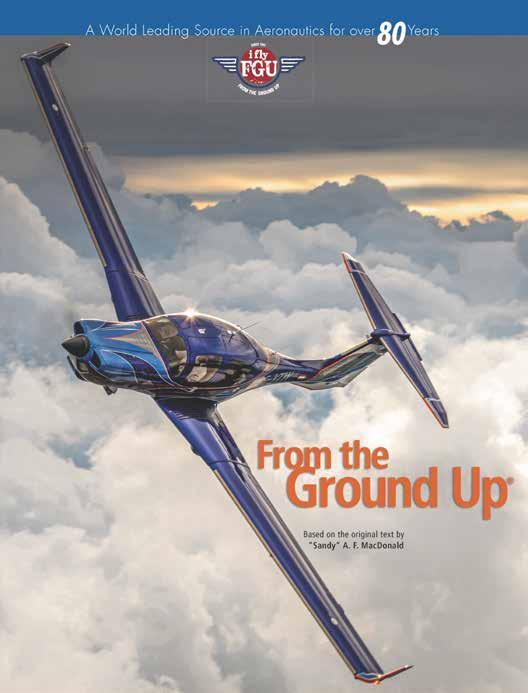
Not one to permit his vast experience to allow for foregone conclusions, “Sandy” MacDonald’s meticulous care in the creation of From the Ground Up has become the hallmark for its widespread use and respect as the reference manual of choice in hundreds of flying schools throughout Canada and around the world.
Its latest edition is the 30th Edition. A French-language version is also available under the title Entre Ciel et Terre Totalling over 400 pages of in-depth content formatted in a sequential, logical and easy-to-read fashion, the publication boasts over 360 graphics, charts, diagrams, illustrations and photos. An additional full-colour navigation chart and a sample weather chart are included.
All chapters are current in the latest technological and legislative aeronautical matters and cover such topics as The Airplane, Theory of Flight, Aero Engines, Aeronautical Rules & Procedures, Aviation Weather, Navigation, Radio & Radio Navigation, Airmanship, Human Factors, and Air Safety From the Ground Up also includes an extensive index, glossary and a 200-question practice examination.
Since the 1940’s, virtually every student — civilian, military, commercial, recreational — who has ever learned to fly in Canada has used From the Ground Up as the primary ground school textbook from which they’ve learned everything one can learn about aeronautics, and about flying. Referred to as “the bible” of ground school instruction, and updated with every frequent re-print, From the Ground Up has long been considered an essential resource for all with any interest whatsoever in the theory of flight, and in the practice of aviating.
For more information about this title, visit us on the web where you can obtain details on how to acquire this, and all of our other aeronautical publications.
Published by Aviation Publishers Co. Ltd.
A World Leading Source in Aeronautics for 80 Years
AVIATION PUBLISHERS CO. LIMITED Box 1361, Station B, Ottawa, Ontario, Canada, K1P 5R4 www.aviationpublishers.com
aviationpublishers.com
A v a ilable from
IN THIS ISSUE

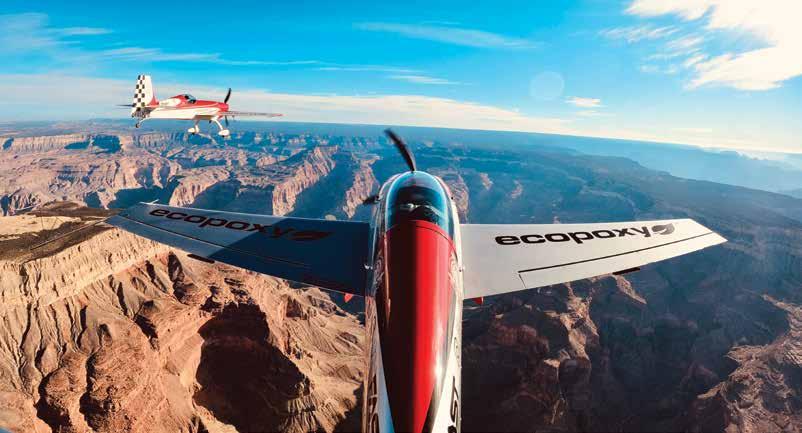
DEPARTMENTS
5 / WALKAROUND
For the thrill of it
6 / WAYPOINTS
Aviation news
By Aviator Staff
7 / GEAR & GADGETS
Four aviation products
By Aviator Staff
8 / AIRMAIL
Up for adoption
By Aviator Staff
8 / FLYING STORIES
The Island’s Islander
By Jack Schofield
10 / THE PLANE FIXER
It’s becoming a woman’s world, too
By Liana Buessecker
12 / TALES FROM THE LAKEVIEW
Douglas’s workhouse
By Robert S. Grant
14 / EXPERT PILOT
Ferrying can be complicated
By Richard Pittet
16 / UNUSUAL ATTITUDES
On coaching Team Canada
By Aaron McCartan
18 / A PILOT’S LIFE
DEW line talk
By Chris Weicht
20 / INSTRUMENTAL FACTS
Displayed vertical paths explained
By Ed McDonald
22 / VECTORS
Do you really want to cancel IFR?
By Michael Oxner
24 / DOWN EAST
Searching eastern shores
By Don Ledger
26 / RIGHT SEAT
Off-airport landings
By Mireille Goyer
27 / PEP TALK
A briefing on pre-flight briefings
By Graeme Peppler
28 / ON THE ROCK
The disappearing Swede
By Gary Hebbard
30 / COLE’S NOTES
Get ‘er done!
By W.T. (Tim) Cole
50 / BOOKSHELF
Top aviation titles
52 / SERVICE CENTRE
Deals and offers
54 / FLIGHT BAG
Puzzle and questions
ON THE COVER
The skies over Nevada were filled with several red and white aerobatic competitors from Canada.
FEATURES
32 Competing with the Best
Team Canada captain Luke Penner provides us with the exciting details of the team’s performance at the 2023 World Advanced Aerobatic Championship in Nevada.
By Luke Penner
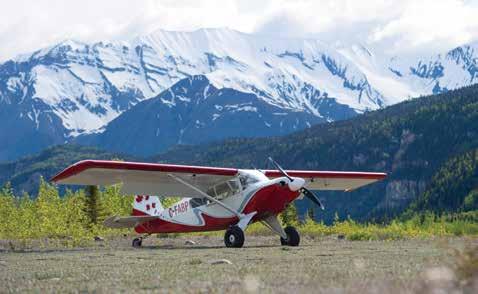
40 North to Alaska
A pair of taildragger pilots tour the spectacular glaciers and scenic backcountry airstrips of northwestern British Columbia and southeastern Alaska.
By Curtis Penner
46 De Havilland’s Venerable Buffalo

Ottawa’s Canada Aviation and Space Museum invited Canadian Aviator to the unveiling of the last RCAF Buffalo, now on display. Our contributing editor takes us behind the scenes.
By Robert S. Grant
MAR/APR 2024 VOLUME 34 NUMBER 2
Photo by Spencer Davis
RICK HIEBERT CANADIANAVIATOR.COM 3
LUKE PENNER

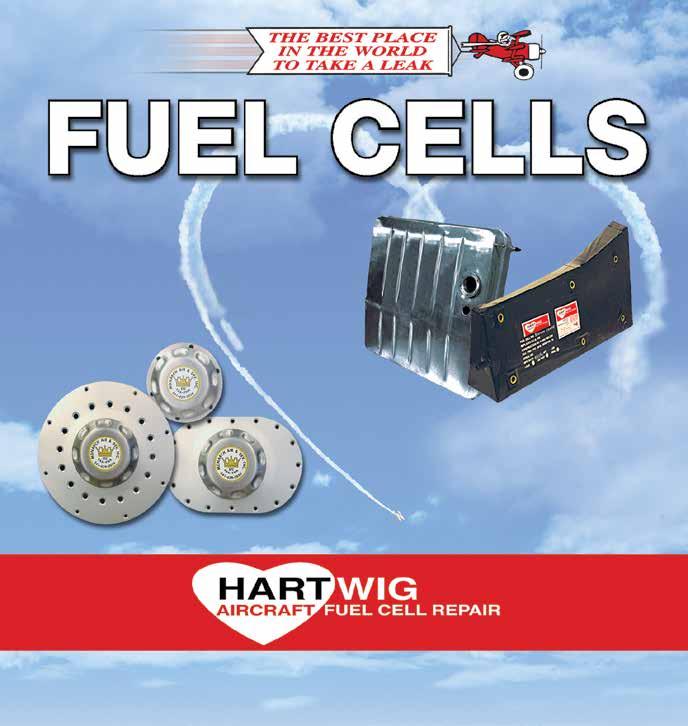
publisher + editor Steve Drinkwater steve@canadianaviator.com 604.999.2411 contributing editor Robert S. Grant graphic designer Janice Hildybrant advertising sales account manager Katherine Kjaer katherine@canadianaviator.com 250.592.5331 director of consumer marketing Craig Sweetman ADMINISTRATION group controller Anthea Williams awilliams@opmediagroup.ca Office 604.428.0261 subscriptions Marissa Miller marissa@opmediagroup.ca 1.800.656.7598 Canadian Aviator is published six times a year: Jan/Feb, Mar/Apr, May/Jun, Jul/Aug, Sep/Oct, Nov/Dec Canadian Aviator Publishing Ltd. 802-1166 Alberni Street Vancouver, B.C. V6E 3Z3 Phone: 604.999.2411 canadianaviator.com Printed in Canada. Agreement No. 42583014. Postage paid at Vancouver, B.C. Contents copyright 2024 by Canadian Aviator Publishing Ltd. All rights reserved. ISSN 1492-0255. Return undeliverable Canadian mail to Circulation Department. 802-1166 Alberni St., Vancouver B.C. V6E 3Z3. From time to time we make our subscribers’ names available to reputable companies whose products or services we feel may be of interest to you. To be excluded from these mailings, just send us your mailing label with a request to delete your name. Publications Mail Registration No. 10939. 50% SUBSCRIPTION HOTLINE 1.800.656.7598 CanadianAviatorMedia @canadianaviatormag canadianaviator.com subscription inquiries admin@canadianaviator.com subscription rates 1 year (6 issues) $26.00 (Taxes vary by province); Outside Canada: $32.00 per year editorial submissions Editorial contributions should be sent to the editor by email in plain text with high-resolution photos attached: steve@canadianaviator.com MONARCH PREMIUM CAPS Premium Stainless Steel Umbrella Caps for yourCessna177 through210 www.hartwigfuelcell.com info@hartwig-fuelcell.com US: 1-800-843-8033 CDN: 1-800-665-0236 INTL: 1-204-668-3234 FAX: 1-204-339-3351 NEW TANKS - 10 YEAR WARRANTY Keeping aircraft in the air since 1952 SPECIALIZING IN BEAVER & OTTER FUEL CELLS QUOTES ON: Cherokee Tanks Fuel Cells & Metal Tanks Repair, overhauled & new Technical Information or Free Fuel Grade Decals Keeping aircraft in the ROTECH MOTOR LTD. 1-(236)-600-0137 SALES@ROTECHMOTOR.CA ROTECHMOTOR.CA AUTHORISED ROTAX DISTRIBUTOR XPS AVIATION ENGINE OIL Formulated specifically for Rotax aircraft engines. FORMULATED FOR THOSE WHO CARE. 4 CANADIAN AVIATOR MAR/APR 2024
The Pursuit of the Thrill of Flying
Most if not all of us remember the thrills we got in the early days of flying. Some of us renew that thrill every so often by taking on a new challenge, such as a float rating, night rating or obtaining a tailwheel endorsement and flying to backcountry airstrips. Some decide to point the nose of their aircraft west and tackle the Rocky Mountains and beyond.

Yet for some of us that is still not enough. The cover story of our Nov/Dec, 2023 issue featured two Canadian teams that competed in the 2023 Reno Air Races — the last competition to be held at that venue, by the way. Edmonton’s Outlaw Racing Team and Calgary’s Atomic Pumpkin
flew the Canadian flag at Reno-Stead airport. Racing may have come to an end in Reno, but it will continue elsewhere, and we hope both Alberta teams, and perhaps others from Canada, will be there.
And for others yet, for whom air

racing is not quite the thrill they were looking for, decide to tackle aerobatic flying instead. Our own Luke Penner, who writes about aerobatic flying in his regular column Unusual Attitudes, penned this issue’s cover feature of the 2023 World Advanced Aerobatic Championship in Nevada. Penner, as Team Canada’s captain, is also an aerobatics instructor at Manitoba’s Harv’s Air Inverted where he has trained some of the team’s members.
All of these competitors are living the dream many of us had, or for some, still have. The rest of us will have to be content with watching them from the ringside. Or reading about them.


WALKAROUND EDITORIAL
ONE STOP SHOPPING • LOWEST PRICES • SAME DAY SHIPMENT ORDER YOUR FREE 2023-2024 CATALOG!
BY STEVE DRINKWATER
CANADIANAVIATOR.COM 5
KENN SMITH
WAYPOINTS
The Next Step in Powered Flight
SEALAND OF B.C. LEAPS TO A NEW ERA IN FLIGHT TRAINING
Soon to grace the skies over central Vancouver Island will be an aircraft designed in Slovenia and built across its border with Italy — a batteryfuelled, electrically powered Pipistrel Velis Electro. By the time you read this, Sealand Flight of Campbell River should have received this newest addition to their training fleet.
Pipistrel, acquired by Textron Aviation in 2022, began developing electric airplanes in 2007 with the Taurus Electro.
Seventeen years later, the Velis Electro is now type certified for Day VFR pilot training in over 30 counties.
The Velis Electro has a maximum cruise speed of 98 knots, a maximum altitude of 12,000 feet and has a useful load of 378 pounds. Its endurance is estimated at 50 minutes plus reserve. These parameters, significantly less than traditional training aircraft powered by internal combustion engines (ICE), are more suitable for training duties within an airport environment or close by.
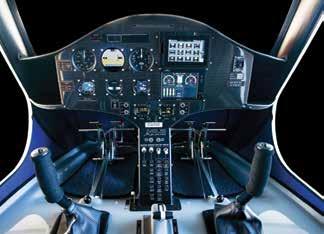
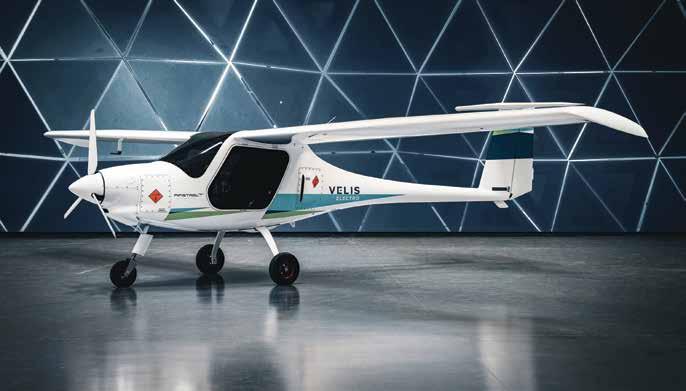
dual liquidcooled lithiumion batteries that are not designed to be easily removed but are quickly recharged.
may work out to be a savvy investment for flight schools.
“With the industry moving towards electric-powered aircraft, there will be a need for pilots trained in that environment,” Sealand’s general manager Nancy Marshall told us. “Harbour Air is an example,” she added.
Canadian Aviator did a cover story and flight review on another Pipistrel electric aircraft, a privately owned Alpha Electro, published in the May/ June 2018 issue. A major difference between these two aircraft lies in the battery technology. The Alpha Electro uses two 10.5 kWh lithium-ion batteries that can be easily removed. With the ground charging equipment and a set of spare batteries, turnaround time is minimized by swapping batteries after each flight. In contrast, the Velis uses
“The time to recharge is about the same time it takes to discharge,” Sealand’s Mike Andrews told Canadian Aviator, meaning that it would take about 45 minutes to recharge after a 45-minute flight. “We’ve got a team of electricians and an electrical engineer helping us devise temporary and eventually permanent charging infrastructure at CYBL, CAH3, CAT4, and CYPW [Campbell River, Courtenay, Qualicum Beach and Powell River airports.]”
With no CO2 emissions and a considerably reduced noise footprint, the Velis Electro should prove popular with those who want a more environmentally friendly training experience. And with no direct fuel costs other than an increased electricity bill, and far less maintenance costs, the more than $300,000 investment
Sealand is working with Transport Canada to develop a training syllabus that recognizes the unique characteristics of an all-electric aircraft. Sealand will also require both a special airworthiness certificate and a special operations certificate from Transport Canada to operate the aircraft.
Sealand joins Ontario’s Waterloo Wellington Flight Centre, which has been operating a Velis Electro since early last year. Their experience has seen the aircraft achieve an average of seven circuits before arriving at the State of Charge (SOC) level of 30 percent, which is what Pipistrel sets as the reserve. This assumes an SOC of 100 percent when the power is turned on at the start of the flight lesson.
Watch for a flight review of the Velis Electro in an upcoming issue.
COMPILED BY AVIATOR STAFF
6 CANADIAN AVIATOR MAR/APR 2024
PHOTOS: PIPISTREL
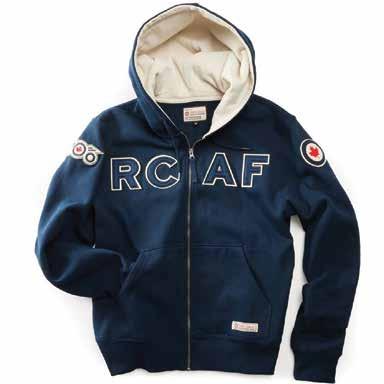
Zippered Hoodie
Canada’s Red Canoe apparel maker is honouring the proud history of the Royal Canadian Air Force by offering in this 100th anniversary year a zippered hoodie emblazoned across the front with ‘RCAF’ and with an RCAF roundel on one shoulder and a stylized roundel with ‘100’ on the other. It’s available only in navy blue. Made of cotton-rich fleece. About C$100.
Learn more at redcanoebrands.com. Available from redcanoebrands.com and vippilot.com.
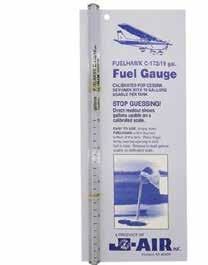
Fuel Dip Stick
Take the guessing out of fuel quantities by using a Fuelhawk transparent dipstick calibrated for the aircraft you fly. Stop relying on eye-ball estimates or crude sticks that don’t take the irregular sizes of typical GA fuel tanks. And, of course, never rely solely on panelmounted electronic fuel gauges that are notorious for erroneous readings. Select from common aircraft types with dipsticks calibrated for your specific aircraft model. Dipsticks for Cessna 152s through to 182s, and their various tank capacities, are available as well as for Cherokee 140s. Universal models are also available. About C$20 to $27.50.
Learn more at, and available from, pilotmall.com and aircraftspruce.ca.
ADS-B Receiver
uAvionix is marketing what they call the pingUSB, a dual-band ADS-B traffic receiver which allows users to be informed of nearby air traffic on their favourite electronic flight bag (EFB) app or on their desktop computer by using the built-in USB connector, allowing it to connect to PC-based air traffic monitoring programs. The device is mounted to a window using a built-in suction cup. It monitors both 978 MHz and 1090 MHz ADS-B frequencies and displays the monitored traffic on EFBs such as ForeFlight, EasyVFR, AirMate and Oz Runways via its built-in WiFi. The pingUSB measures 34 mm x 19 mm x 8 mm and weighs only 5 grams. About U$275.

Learn more at, and available from, uavionix.com
Engine Pre-Heater
Although by the time you read this, winter may have already come to an end. Nevertheless, now is a good time to reflect on the past few months and admit that there were a few days you decided not to go flying because the engine would have been too cold to risk damaging it with a very cold start. Reiff Preheat Systems of Wisconsin offers a thin and lightweight oil sump heater with dual 100-watt elements that is thermostatically controlled. Approved for use with most GA Lycoming and Continental piston engines. About C$393.

Learn more at reiffpreheat.com. Available from reiffpreheat.com and aircraftspruce.ca
PRODUCT REVIEWS COMPILED BY AVIATOR STAFF
GEAR & GADGETS
CANADIANAVIATOR.COM 7
AIRMAIL
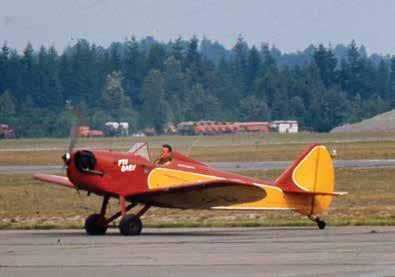
Metamorphosis of a Fly Baby
I’m sure that many of your readers did a double take when they saw the cover of the Jan/Feb 2024 issue — a biplane Fly Baby. Most folks are used to seeing the Fly Baby as a low-wing monoplane. My late friend Peter Bowers used to bring his original Fly Baby (N500F) up to the early Abbotsford Airshows, and one year he brought along some extra wing panels and converted it to a biplane at the show. See a scanned slide from the (1963 or 1967) show.
Jerry Vernon President, Vancouver Chapter Canadian Aviation Historical Society
An Islander for the Island
BACK WHERE SHE BELONGS?

Back in 1969, a successful logging company owner, Donald E. Braithwaite, of Campbell River, British Columbia bought out his accountant partner in Trans Mountain Airlines (TMA), changed the name to Gulf Air and relaunched the popular Class 4 Vancouver Island air service. That same year Braithwaite purchased a Britten-Norman BN-2 Islander from the Isle of Wight factory in the United Kingdom and gave it the Canadian registration of his initials, CF-DEB.
“What colour, guvnah?” came the voice over the phone from the British island.
Machine,’ but not on floats for this addition to the fleet, a tricycle-gear, 12-passenger light twin powered by two IO-540 300-hp Lycomings. Lots of flap, big high tail, land on a dime and give eight cents change with a funny door arrangement for control of the weight and balance when loading, and a typical British heater system with a three-position switch, cold, cold and cold. Good airplane: does everything it claims. The new Islander would join Gulf Air’s one single Otter amphibian to provide service into the increasing number of private dirt strips being used by the big logging companies.
steve@canadianaviator.com
“Paint it green,” replied Braithwaite. “What else?” muttered chief pilot Stan Kaardal, sitting nearby. “Everything else around here is green.” It being a joke that one should not stand in one spot for too long for fear of being sprayed Don’s favourite colour.
Thus, DEB became the next ‘Green
The big logging companies were suddenly the problem. Once 13 in number, they were fast disappearing, and a very new situation was taking place within the industry; financier Jim Pattison was about to take it over. He would buy all six of the floatplane operators on the Coast, calling the new company Air BC. He had over
FLYING STORIES
HANGAR TALK WITH JACK SCHOFIELD
us your letters Canadian Aviator welcomes reader letters on topics of concern to Canadian pilots and the aviation industry. Please be brief, to the point and polite in your submissions.
Send
Email Steve Drinkwater
8 CANADIAN AVIATOR MAR/APR 2024
EDUARD MARMET
120 Cessnas, Beavers and Otters, and many of them were destined to be auctioned off by a heavy-duty equipment auction house based in Vancouver. Sadly, there, amongst the many floatplanes on the auctioneer’s block, was our now-fading green Islander DEB. It was the first to go. A young novice aviator purchased it for the purpose of making a trans-Atlantic flight to Britain.
“You’re crazy to attempt such a flight in a utility aircraft like that,” said the man standing next to him at the auction. “I’m a Cessna dealer. I’ll take that machine off your hands and put you in the right airplane satisfactory for a trans-Atlantic flight!” This Cessna dealer was true to his word and joined the young man to fly the Islander back to his own home base close to Washington D.C. The young man purchased the recommended aircraft from our smart salesman, DEB was given a top overhaul on both engines and put on the lineup of aircraft for sale at his private airport.
that I would pass on their proposition.
“Good airplane: does everything it claims. The new Islander would join Gulf Air’s one single Otter amphibian to provide service into the increasing number of private dirt strips being used by the big logging companies.”
When I got to Vancouver on that flight I passed on the information to the dispatcher, and he sent me to Victoria to so advise the airline’s owner of this offer. I won’t dwell on this, but the owners must have thought I was complicit with the Qualicum businessmen and fired me on the spot! The old Greek parable comes to mind: “When in doubt, shoot the messenger.” When I confronted the group’s spokesperson, Ken Fyfe, with my news, he pushed a Trade-a-Plane under my nose, stabbing his finger on an aircraft listing, “I just bought that sucker lock, stock and barrel sight unseen, and you and I are going back to Cambridge, Massachusetts to get it!” Sure enough, it was an BN-2 listed by an eastern Cessna dealer. Ken Fyfe was a guy who made things happen!
That should be the end of DEB’s history concerning myself, but far from it. Fast forward to when I was employed by Burrard Air in the mid1980s. I was flying a scheduled seven flights per day between Qualicum and Vancouver International Airport. Prior to takeoff from Qualicum one morning, a party of six local businessmen approached me and asked if I would present a proposition to the current owner of Burrard Air to sell them one of his airplanes and transfer the licence for the Qualicumto-Vancouver service to them. They wished to keep the air service in good equipment and owned locally. I was a bit stunned by the request but agreed
Following a hilarious turn of events, we learned that there were two Cambridges in the U.S. and American Airlines helped us find the right one in the state of Maryland. (Sorry about that, Paul Revere!) They dropped us at Baltimore, Maryland, and we were picked up there by the seller of the Islander in a dazzling Cessna business twin. We whisked over John Kennedy’s favourite sailing waters onto final for the company’s private paved strip in Cambridge, Maryland. We could see the distant buildings of the White House across Chesapeake Bay as we descended. We could also see in a lineup of planes along the strip a high-tail in green with the now indistinguishable letters that I knew would spell Don Braithwaite’s initials — DEB.
To be continued in the next issue…

CANADIANAVIATOR.COM 9
Will it Remain a Man’s World?
DON’T BE SO SURE
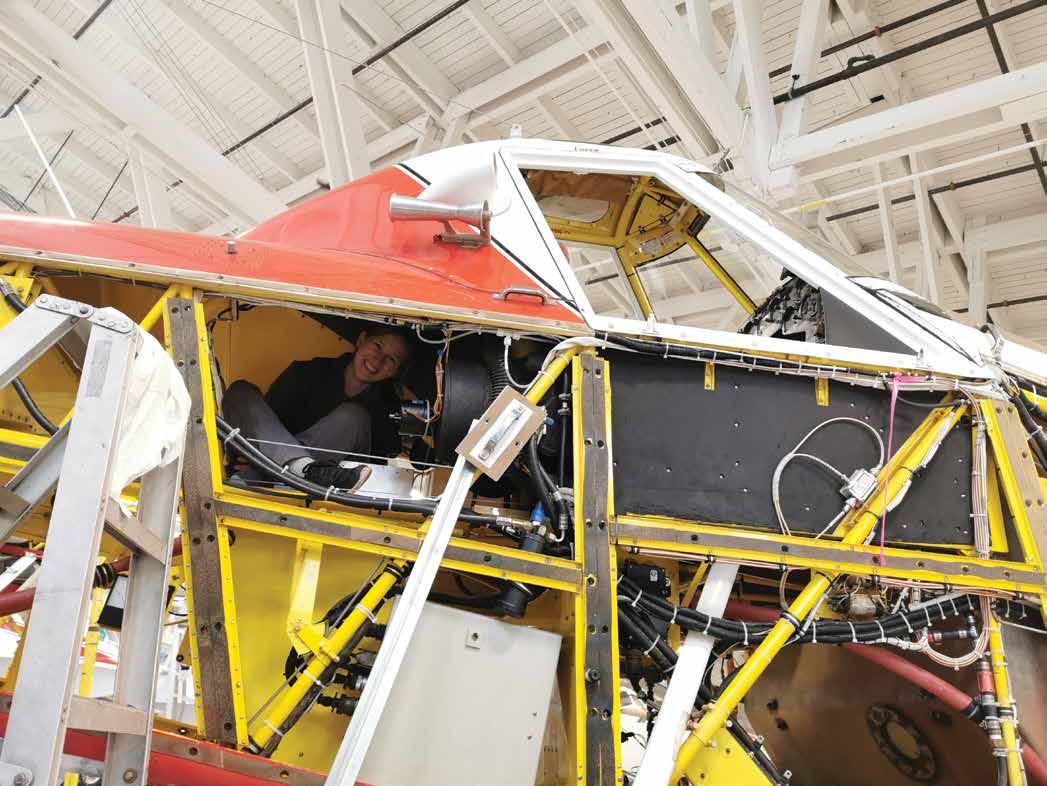
On more than one occasion in my career I have asked a colleague if I can borrow his muscle, similar to how one might ask if they could borrow a bigger hammer. My tools (or muscles) just aren’t quite enough to complete the task at hand. Bear in mind I do own the biggest breaker bar in the hangar — four feet of sheer will power — and it’s come in handy for a few of the guys, not just me. It may take my entire bodyweight to torque a propeller blade, and I may not be able to install a main tire brake assembly by myself, but being a petite woman also has its advantages.
While I ask to borrow muscle, my male counterparts ask to borrow my small hands. What might be considered a confined space entry for them because they must calculate how they’re going to fit their shoulders through the access panel, and what might happen if they get stuck, and what if they don’t have the right tools (they can’t just step out to grab something) is simply an in-and-out operation for me. When my colleague dropped his screwdriver in the bottom of the float bay, he sat peering in the hole for a long moment contemplating the best plan of attack to retrieve it. “Does anyone have a super long, strong
magnet I could borrow?” he asked around. I took one look in the small access panel and shrugged, “Hold my ankles,” and head-first I went.
The Air Tractor 802 is a unique aircraft and in many ways is a mechanic’s dream; the aircraft is made entirely of panels. Everything comes apart during maintenance, giving complete access to everything. I was recently assigned with removing avionics components from behind the cockpit. I assessed the area from both sides, confirmed what tools I would need, and climbed inside the structure of the aircraft, skirting over flight control wires and underneath
THE PLANE FIXER SWINGING WRENCHES WITH LIANA BUESSECKER
10 CANADIAN AVIATOR MAR/APR 2024
Author Liana Buessecker demonstrates her ability to take on tasks that most of her colleagues are unable to.
electrical bundles. When someone called for me and I responded, they walked by me twice before realizing where I was.
When a pilot reported a potential bird strike on a Q-400 during an aircraft turnaround, my superior immediately called me for the inspection because I fit inside the intake of the engine, saving tremendous time in having to lower the cowling. And while greasing the landing gear will never be anyone’s favourite task — there are 50-something grease points on each main gear of the Q-400 — I’m often given the task simply because I can climb up in the gear bay and reach all the grease fittings, whereas some guys who are taller and bigger cannot.
There’s a running joke that being small in the aircraft maintenance industry guarantees you specializing in fuel tank entry. It would certainly be a con if you were claustrophobic. Aside from any physical constraints, there are certainly other obvious obstacles as well.
There are a lot of organizations nowadays encouraging and advocating for women in the industry, and while they are incredibly inclusive and supportive, I’ve found they seldom talk about how difficult it actually is. Nobody wants to talk about the scary stuff in fear of it discouraging the next generation, but if we don’t talk about it now, then how will it ever change?
Aviation is an old boys’ club and anyone who tells you differently probably doesn’t work in maintenance. I have fought for my seat at the table and to prove I deserve to be there. There are certainly dinosaurs in the industry, old men set in their ways who refuse to be inclusive or admit the industry (and the world) is changing, but there are also men on the other end of that. My team at Jazz in Calgary was the best crew I have ever worked with. At no point did I ever doubt myself or my place, and neither did they. I owe so much to those guys, because if I hadn’t had such a positive experience with them, I may have given up in rougher water.
My experience hasn’t always been as smooth sailing as my time there. I have

had men tell me to consider a cleaner career, something I will be able to continue doing when I inevitably bear children — do I even understand the potential dangers aviation poses to a fetus? — and to stick to what women are meant to do.
Even when I took a temporary desk position in quality assurance during the pandemic, I was doubted: how could I possibly know everything I needed to know at my age?
from their toolboxes? Was I going to demand to be treated differently (or specially) because I’m a woman? And if the answer to any of those questions is yes, that woman probably doesn’t have what it takes to thrive in maintenance.
“Aviation is an old boys’ club and anyone who tells you differently probably doesn’t work in maintenance. I have fought for my seat at the table and to prove I deserve to be there.”
I’ve had guys physically take tools out of my hands and tell me they are surely too heavy for me to handle. I’ve been the last given an assignment, only to be tasked with paperwork. I’ve been asked if I’m okay to do that job because I might get dirt under my nails. I’ve spent an entire shift holding a flashlight for someone else, and I’ve had a complete stranger and grown man think it’s appropriate to ask how much I weigh.
When my colleagues heard a woman had been hired, they admitted to me some time later that they were initially nervous. There wasn’t a single other woman in the hangar: were they going to have to worry about everything they said? Would they have to remove any dirty or inappropriate stickers
To the men who were worried about the language they use: I’m a firm believer that cussing at the aircraft gives you extra strength, and remember I can use all the extra strength I can get. To the guys worried about what they have pasted on their toolboxes: I see your Vegas stripper cards and raise you a Thunder from Down Under calendar. And to anyone worried I’m going to ask for special treatment: I will absolutely challenge you to a donut-eating competition — I will lose by a long shot because I am tiny. And immediately after I will grunt and groan as I drag my six-foot toolbox across the floor to prove my tools are bigger and better than yours.
Being a woman in a man’s world isn’t always sunshine and rainbows. But here’s a fun fact about women in aviation: we are resilient. When you say jump, we don’t ask how high, because we’re already busy giving it our all.
CANADIANAVIATOR.COM 11
Servicing a four-engined Avro RJ85 AT aerial tanker.
The Douglas DC-3
A LEGENDARY WARBIRD CUM CANADIAN BUSH PLANE
My flattened fingers eased the Douglas DC-3’s throttles to takeoff power and 56 spark plugs encouraged miscellaneous engine parts to come to life. Empty, CF-FTR weighed 16,939 pounds with the 1200hp Pratt & Whitney R-1830s turning 11-foot, 6-inch hydromatic propellers at 2,700 rpm. As airspeed increased, vibrations shifting from the pebbled airstrip encouraged perspiration aromas to ascend from my flight suit and flavour our microworld. At 76 knots, the 64-foot, 5-inch fuselage levitated and moments later the ‘C-47B-25 DK’ turned to a southward heading. We were going home.
A few weeks before, Gimli-based First Nations Transportation operations manager Fred Petrie suggested joining his organization as a ‘Three’ captain. In
1973, I had occupied the right seat on a trio of the elegant ‘sky climbers’ for Arctic Air in Fort Nelson on the Alaska Highway. Other opportunities brought on departure before gaining enough experience to slip to the left. Now, decades later with several more piston radial types in my logbook, Petrie had no idea he offered a route to a long-sought goal. The first look at CF-FTR in Gimli, north of Winnipeg, however, was not encouraging.
Below the 14-cylinder powerplants pooled oil from the 48.2 imperial gallon tanks darkened the hangar floor and above, pink hydraulic fluid glistened in wheel wells. Greenish fuel dripped from drains and the belly batteries released white acid streaks as far back as the elevator. Dents and dimples marked the age-tarnished 24ST fuselage while
slipstream-shredded duct tape patched the seagull-stained control fabric.
Dried ice cream made the 38-foot cargo floor slippery and grease from squashed plastic pails dotted the walls. Reaching the so-called “Place of Repose,” or cockpit, meant stepping over a cable winch bargained from Gimli’s Canadian Tire. A finger-printed Trimble 300 GPS with cracked plastic case lurked in a panel opening crafted with a hacksaw blade. Visual flight rules only. Freight runs would take place where herds of turbine twins dominated lightning-blasted boreal tracts near Manitoba’s Indian settlements. We were not exactly ploughing pioneering furrows into wilderness sky. Air services from hundreds of miles around sent their white-shirt multi-striped prima donnas north.

TALES FROM THE LAKEVIEW BUSH FLYING WITH ROBERT S. GRANT
Compressed seat padding brought little comfort in CF-FTR. Each 1200-hp Pratt & Whitney R-1830-92 weighed 1467 pounds and on runs north of Gimli, loads averaged 7,000 pounds. 12 CANADIAN AVIATOR MAR/APR 2024
Together with fellow captain Gary Foster and swamper Brad Danks, we dared not neglect broadcasting positions as we steamed forward above Jack pine, spruce and muskeg mud between fog patches. Maintaining guard for microwave towers and inbound melees of IFR traffic formed our safety package. On crushed rock airstrips, we strove to plant our 1700 x 16 tires at the extreme end; never beyond thresholds as flight schools taught their novitiates.
After retraining with DC-3 virtuoso Duane Dick, chief pilot Jeffrey Schroeder arranged a Transport Canada check ride in Winnipeg with an examiner who concluded the air test with passing marks. Back in Gimli, Schroeder reviewed my God-forsaken nose-down steep turns and erratic approaches and kindly kept me on the payroll. After line indoctrination, work began exclusively for North West Company retail stores.
Built in 1944, CF-FTR’s documents showed almost 27,000 hours under many owners. At allowable 26,900-pounds gross weight, fuel burn averaged 600 pounds per hour hauling merchandise absolutely essential beyond civilization’s solace. Company loaders herc’d down Ecuadorian bananas, Winnipeg cheese snacks and Mister Noodles on colour-coded wood pallets. Once, a 42-pound Tummy Trimmer rattled beside cardboard-wrapped Ford panels along the sloping floor.
and so were the spiders observed behind wall panels.
At most destinations a forklift stood by to unload, but at the quiet Cree community of Red Sucker Lake, none existed. Every pound, package and piece of leather-covered furniture had to be manoeuvred through the two-piece left side cargo door. On ‘pop runs,’ never-ending soft drink cartons blistered our palms, and the crushed ones soaked our socks. Occasionally, passing pilots volunteered to help unload yet stood
did their damage and the hand-pumped hydraulic floor jack bruised through safety boots.
For the project’s final engine start, we electric-primed, set throttles and cranked propellers 10 times before flicking on magneto switches. Bluish black smoke enveloped cowlings and orange flame sheeted backwards in the dim dusk. Both R-1830s idling smoothly, Foster read checklists and the 45-psi tires softened the ride as we taxied away. No one said goodbye or thank you.
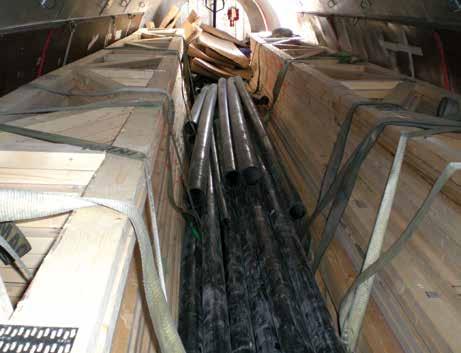
stunned when they stepped into CFFTR’s stone age “functional minimalism” and gaped at frayed bungee cords supporting the compass. Most marveled at the labyrinth of aging pistons, pushrods and pumps saturating soil below the wheel wells.
Airborne, the 95-foot multispar fail-safe wing carried us homeward as the magnetic compass seeped fluid and the bungees blurred. I looked back into the cargo compartment where wood chips and steel wrapping bands danced on plywood-protected floor panels. Hercules straps dangling from the ceiling resembled a Rastafarian wig. In cruise, our team relaxed. Antique, no doubt, CF-FTR, one of 13,142 Douglas DC-3s produced, fulfilled its task. Not once did an engine self-destruct internally, and no wind-blown cargo doors pulped anyone’s fingers.
Cruise at 124 knots usually took place below 5,000 feet or potato chip bags burst. Trickling fuel drums and fluttering zinc chromate flakes improved our lunchtime sandwiches. We dreaded rain. Downpours penetrating window seals through rolled-up paper napkins soaked our knees. Liquid dribbling into the Trimble GPS rendered it useless. Navigation charts turned to mush. Lacking radar, radio altimeters or strike finders, we appreciated the gift let loose by Mr. Donald Douglas on December 17, 1935. Blackflies resting on the tape-wrapped control column were happy campers
Petrie landed a weekend contract to move prefabricated houses from Gillam, 107 miles southeast of Thompson, to the settlement of Shamattawa. Esprit de corps really shone at FNT even on days off and everyone, including the Curtiss C-46 crew, resolved to do the job. Each leg averaged 35 minutes. Tons of lumber, galvanized nails and glass windows went aboard, and we levered everything out at destination. Despite leather gloves, slivers channeling under fingernails brought on what writer Ernest Gann described as “consuming waves of agony.” Scalp-scraping doorframes
At Gimli, 45° landing flap helped touch asphalt at 85 knots and, a few weeks later, the cold weather season shut First Nations Transportation down. I had revelled in the shimmers, shakes and thuds of an exhaust-stained legacy, but knew brief exposure to the “Vomit Comet” could not make me a DC-3 artisan like the Sam Coles, Daniel Genests and other masters who came before. The bonus came from several hundred sovereign hours handling a great, great airplane and inexplicable delicious moments known only to those who fate blessed into the left seat.
Besides gazing at muskeg mud, another bonus fell my way during the same summer odyssey. Fragrances of splashed 100/130 avgas on my boots lessened wait times in Gimli’s supermarket checkout lines.
CANADIANAVIATOR.COM 13
Every board, pipe and nail keg was moved by hand and more than one finger found itself flattened during flights from Gillam to Shamattawa.
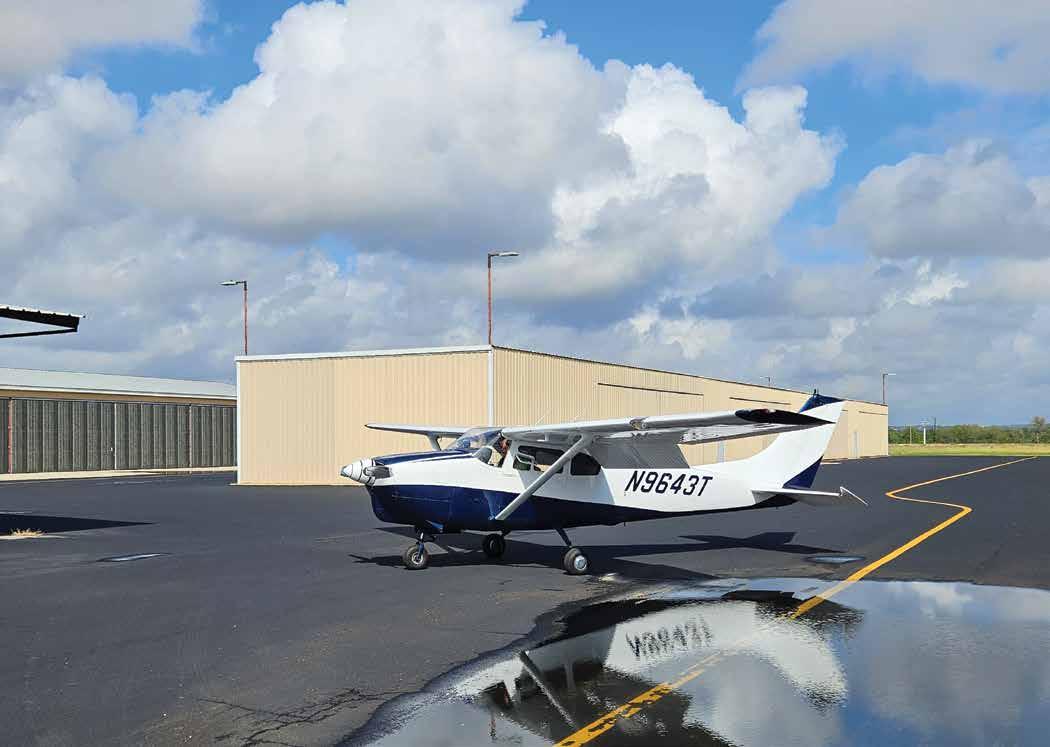
The Perils of Ferry Flying
HOW A TWO-DAY FLIGHT TURNED INTO A MONTH-LONG JOURNEY
Afew months back the owners of Kanata Aviation Training in High River, Alberta asked if I’d help one of their recently graduated students, Tim Taylor, ferry a Cessna 210 he’d purchased in Texas to its new home near Calgary. Being a big fan of 210s, I jumped at the opportunity. After all, what do airline pilots do on their days off, if not go flying?
The final plan had a lot of moving pieces. A major winter storm was forecast to hit the Denver region less than 48 hours after our arrival in San Antonio, making departing Texas early the next day critical. To up the stakes even more, I was due to ferry another airplane, this one a Boeing 787 with 275 passengers aboard, to London just four days later.
Before I tell you what actually happened, first let me share a few things I’ve learned in nearly 50 years flying GA. First, never board an airplane with the express purpose of picking up another
airplane until it’s been confirmed the second aircraft is fully reassembled, signed off as airworthy and is literally ready to go. The second rule: if your schedule is weather-dependent or even remotely time-critical, plan to fly another day, week or even month. Suffice it to say we were both ignorant of Rule No. 1 being broken by an unknown third party and were far too optimistic about our ability to work around Rule No. 2.
Day 1. Arriving in San Antonio, we jumped into our rental car and zipped out to nearby Castroville Municipal Airport. Our ambitious plan depended on me test flying the Cessna that afternoon, then be poised to depart early the following morning. What we discovered instead was a 63-year-old 210 in what appeared to be a million pieces. Attending to the mechanical fray was the airplane broker’s hired mechanic, a less than confidence-inspiring gentleman. In addition to finding it necessary to
expound on his limitless knowledge of Cessna aircraft, he insisted on throwing in repeated references to musician George Strait, whom we were presumably to infer he knew personally.
My love of country music notwithstanding, as the yakking continued, I found myself growing increasingly uneasy with his selfproclaimed expertise. Rather than wait out the process at our hotel, we instead elected to discreetly hang around and oversee the reassembly of Tim’s 210 from a polite distance.
Mercifully, just before noon the next day, the 210 was finally ready to fly. George Strait’s good buddy insisted on conducting the test flight personally, with me watching from the right seat. The finale was his literally slamming the big Cessna onto the runway, passing his poor handling off as “short-field technique.”
With all the hullabaloo behind us and with tanks topped off, Tim and I finally
EXPERT PILOT FLY LIKE A PRO WITH RICHARD PITTET
14 CANADIAN AVIATOR MAR/APR 2024
Owner Tim Taylor’s newly purchased Cessna 210 at the Castroville, Texas airport.
set out north. The vintage 210 was easily grounding 170 knots under a scattered layer. If we could just get beyond Denver before sunset, we’d be in for a short Day 2. To add to our operational constraints, I prefer not flying an airplane I don’t know well after dark and won’t even consider flying one that is new-to-me and untested, in cloud.
All was going smashingly. Then, about an hour north of Castroville, came this unsettling observation. “Rich… we’re losing fuel.” Tim was watching the left and right fuel quantities slowly moving towards ‘E’. This couldn’t be. Then I recalled the mechanic’s reference to issues with the fuel lines in the wings. Or could it be the Monarch brand fuel caps leaking?
On the “everything’s ok” side of things was analog gauge behaviour following an electrical power loss, specifically that an AC-powered gauge will remain at the last indication shown at the time of electrical failure. In contrast, a DCpowered gauge will move towards zero, making you believe something that might not be the case. In short, “AC lies, DC dies.” The fuel gauges were DCpowered, suggesting that the real culprit was an ongoing electrical failure, but nothing else supported that theory.
In the face of conflicting information, always believe the bad news, especially the sort that will kill you. We were either experiencing a total electrical failure or were about to deal with the more critical problem of fuel exhaustion. Either way we had to land.
In less than 30 seconds we’d carved the big 210 around and pointed it at the nearest field, which turned out to be Brady, Texas. As an added precaution, I elected an overhead break. Minutes later we landed without further event, taxiing to the apron, propeller still turning.
By the end of that first evening, Larry, an octogenarian aircraft mechanic, confirmed that the airplane’s battery was indeed kaput. This wasn’t a surprise; it had seen 12 summers of use, followed by a full year of total neglect. The following morning, with a new Concorde battery installed, we made it just 15 miles north before weather forced us to turn back.
For the next two days we sat in what is known as the “Heart of Texas” waiting for the stationary frontal surface — maliciously parked over Curtis Field, to eventually move. By the end of the second day, my work schedule required that I fly home to Calgary.
A few days later the weather finally broke. Tim and another ferry pilot once again set out for Calgary, only to have a carbon monoxide detector alarm go off when cabin heat was selected. The previous owner had paid to have both exhaust manifolds replaced but neglected to replace the downstream mufflers. Fully corroded, the holes in those components let CO into the cabin heat system, which in turn was the source of the deadly carbon monoxide leak into the cabin. There’s a valuable lesson here about the value of CO detectors and logic of replacing critical components, such as mufflers, when upstream items are no longer airworthy.
Nearly a month has passed since our truncated ferry mission, and I eagerly await the call to complete the delivery. When I last spoke to Tim, his new-to-him airplane was still in Brady. FedEx had lost the set of new mufflers somewhere between California and the Lone Star State. Not one to let a situation get the best of him, Mr. Taylor has Larry, the scooter-driving airplane mechanic, busy installing vortex generators on the 210. VGs will improve the airplane’s already good short field capability and low-speed handling.
Despite everything, the trip had many pluses. I can confirm that I still love Cessna 210s and have added Tim to my growing list of pilot friends. As for Brady and nearby Curtis Field, it turns out that some of the friendliest people you’ll ever meet can be found in the Heart of Texas. That and the best dang Mexican food north of the Rio Grande!

CANADIANAVIATOR.COM 15
Behind the Scenes at the 2023 WAAC
WE HEAR FROM TEAM CANADA’S COACH AARON M c CARTAN
Greetings, my neighbours from the North. Presumably, many readers are aware of the sport of aerobatics yet may not follow the individual competitors. Perhaps a brief introduction is in order. I’ve been involved with competitive aerobatics since 1991 and actively competing since 2007. My competitive career has enjoyed success at regional, national and international events. I’ve been a member of three U.S. aerobatic teams between Advanced and Unlimited.
Almost 10 years ago I met Luke Penner at his competitive debut in the United States and our friendship commenced. We collaborated for many years culminating in his win at the Canadian National Championship during Team Qualification in 2022. Over those years I was gradually introduced to more members of the Canadian aerobatic community, but the trip to Rocky Mountain House, Alberta in 2022 supporting Luke and his protégé, Jesse Mack, introduced me to all but one of the 2023 team candidates. That’s the short version of how I opened the door to coaching a national team.
What does an aerobatics coach do?
Coaching is an interesting role that wears many hats. To perform the duty properly one must develop a good relationship with each of the pilots under their charge. Aerobatics is part physics and part artistic performance. Think of it as an aggressive ballet in the sky. To perform at a high level in this sport, the burden is upon the pilot to present the illusion of perfection and the only way to really hone that presentation is with ground coaching. The coach must understand the expected outcome, learn some of the idiosyncrasies of the airplane and learn the psychology of the pilot. Somewhere in the mix exists a challenge
of identifying mistakes or deficiencies in the performance and being able to communicate a solution to the pilot. The coach also needs to identify when the pilot has met their breaking point and is unable to gain any lesson from the flight; fatigue plays a big role during training. Finally, the trainer must strike a balance between rewarding good performance and reassuring that a missed manoeuvre can be corrected by adjusting slightly. In essence, coaching means equal part professor, shrink and cheerleader.
In sports of high achievement like aerobatics, every detail matters. A change in your seat cushion changes the sight picture slightly, a funny grip on the control stick adds unwelcome pitch to the rolling elements. One miniscule change yields a drastic effect on the outcome of the flight. The key to this pursuit is consistency and faith. Each pilot had to place blind faith in their coach to develop a program tailored to maximize their performance.
In a catalog of thousands of manoeuvres there are times when we would hold back certain aspects or reroute training to attack a deficiency. Doing this at strategic stages and then shoring up those skill sets with related manoeuvres would build confidence and allow us to attack new skills. As each pilot progressed through the catalog there will inevitably be moments of frustration and those “a-ha” moments which are greatly rewarding.
Over the course of training Team Canada in 2023, I had pooled a career of training exercises, and even improvised several new events, to force our pilots to perform under the stressful conditions experienced in the World’s highest contest. One of the favourites was a random ‘Unknown’ figure exercise. At the very end of the flight, after all the prepared and briefed exercises were up to accept-
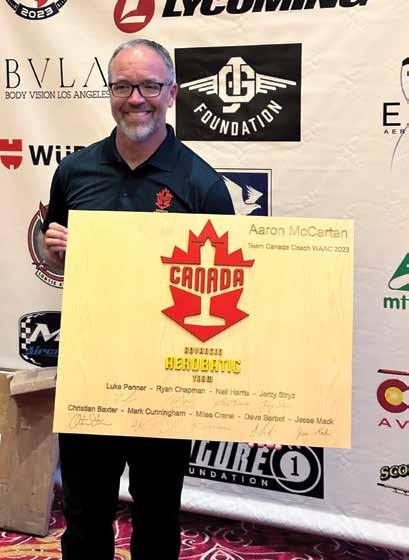
able standard, I would radio the pilot and ask for a manoeuvre completely outside the scope of that flight’s mission. The pilots absolutely loved the challenge of thinking on their feet while pushing fatigue limits. Ultimately this aided in our overall performance at the World Championships.
It Takes a Village
Early in my career I was working with the former trainer from the U.S. Unlimited team and found a struggle with what should be a simple manoeuvre. Loitering in the hangar between flights, one of my fellow pilots offered some satirical advice as we discussed our struggles. What started as a passing comment ultimately was the key to success. This experience shaped the culture of Team Canada’s training camps. When pilots on the team weren’t flying, they were encouraged
UNUSUAL ATTITUDES AEROBATICS WITH AARON M c CARTAN
16 CANADIAN AVIATOR MAR/APR 2024
to sit alongside the coach and spectate; especially if their teammate was operating a similar aircraft type. I would carefully integrate certain comparisons: “This is how it should look,” or “This was what you did differently,” or “Can you help them with this? You’ve been nailing it lately!” This would generate a significant increase in team collaboration and camaraderie. We all raise the level of performance together.
The Result
I could write volumes about competitive format and the level of airmanship required by our pilots to represent themselves at a World Championship event. For a follow-up, I could detail the judging process and how the margins of error between first place and tenth place are razor thin. A game of this calibre is won by the tiniest of details and graded in a very subjective manner which results in scores that aren’t the easiest to understand.
Team Canada’s overall finish at the 15th World Advanced Aerobatic Championships is remarkable and truly something to be proud of. As a coach and friend to the individuals under my charge, I could not be prouder of the progress made by each of our pilots.
At the World Championships teams were issued small event tents as a place to shelter from the sun and park individuals’ gear. Canada shared a tent with France, which was a fun dichotomy. The French team were strictly business. While polite and courteous, they were only on the airfield to conduct their flights and then departed immediately. Team Canada maintained a stronger presence during the contest by being the hospitable and gregarious personalities that the country is known for. Honestly, it was probably the most popular tent for passers-by and even became a social hub.
In the end, three of our aviators made the cut in the top 25 to fly the fourth and final round. For two being rookies at the
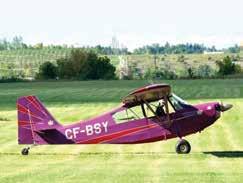

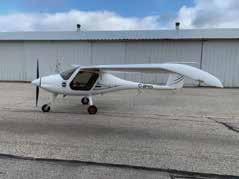

world-level, that is a remarkable standing. France won overall, being almost professionally backed and heavily funded, with Romania on their heels having nearly the same level of support. The U.S. was in third place, having several pilots with extensive world-level experience. Canada respectably placed fourth overall for their first full team showing in decades. That is no small achievement!
I want to close with a special thanks for Lenora Crane for her management of the team and Carole Holyk for representing Canada as our delegate to the CIVA regulatory commission. Those two ladies did more behind the scenes than I can credit. A debt of gratitude is due to Tara and Matt Granson for the countless hours keeping the fleet of competitors in the sky.
And finally, thanks to our Team Canada for having faith and putting in the effort to succeed. You are all exceptional as individuals and our mutual success was a product of your effort.

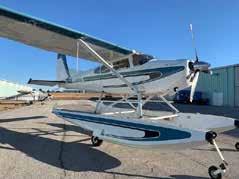
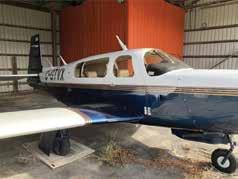
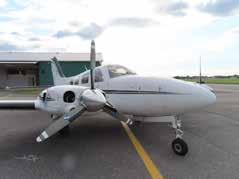

USD $99,000
2010 PIPISTREL VIRUS SW
2005 CESSNA TURBO 206H AMPHIBIAN USD $575,000
1980 BEECHCRAFT 58P
USD $299,500
1980 CESSNA A185F USD $375,000
USD $223,573
2024 PIPISTREL VELIS ELECTRO
USD $89,000 226-666-2192 / sales@apexaircraft.com APEXAIRCRAFT.COM WE KNOW AIRCRAFT
2001 MOONEY M20R OVATION2 USD $259,500 1962 PIPER COMANCHE 250
USD $78,000 CANADA’S EXCLUSIVE DISTRIBUTOR FOR CANADIANAVIATOR.COM 17
1972 BELLANCA CITABRIA 7GCBC
As Luck Would Have It
BEING MENTORED BY PWA’S CHIEF PILOT (PART 2)
Since getting my private pilot licence as an Air Cadet while in high school, I have been thwarted in my attempts to advance in my planned career in aviation due to my visual acuity not being the venerated 20/20.
Even though I had substantially more than the required flight time for the Canadian commercial pilot licence and had passed the exams and flight-tests, the Department of Transport was unrelenting.
It would be later that I was able obtain an American FAA commercial pilot certificate with multi-engine IFR and obtain employment with the U.S. Forest Service after obtaining a U.S. Immigration Green Card.
Now back to the story.
Distant Early Warning (DEW Line) Radar Operation contracts with other airlines also operated out of Yellowknife, NWT, and their crews, a motley bunch, frequented the Ingram Hotel’s bar and
café. Besides the Canadians, some were Americans, also English and some were German. Since it was only a few years since they were fighting each other in the Second World War, there were frequent disagreements that often led to a physical fight. Usually though, sanity prevailed, and the combatants were encouraged to shake hands and have another drink.
The Department of Transport was not often present so frequently the regulation book was thrown out of the window. This was especially the case with regard to drinking. (Eight hours from bottle to throttle.) On one such event a crew from Associated Airways at Edmonton were flying Avro York, registration CF-HMZ, which was loaded with its fuselage crammed with 10-foot by 10-foot lumber about 20 feet long. Well, the crew had not done much de-icing and there was still frost on the wings. The aircraft started
its takeoff run and it quickly became apparent to the pilots that, with frost on the wings and a full load of lumber and full tanks of fuel, the York was not going to fly and it was too late to stop on the snow-covered runway. However, the captain had the foresight just before going into the gravel pit at the end of the runway to apply full right rudder which turned the York sideways, allowing the lumber to break out the side of the fuselage rather than come forward into the cockpit which would have likely killed them both. No one was seriously injured and, except for the aircraft being a total writeoff, everyone was okay.
Sheldon Luck, chief pilot for Pacific Western Airlines’ DEW Line Operations, invited me out for a drink one evening in Yellowknife and asked me what it was like to have my father leave the family. He was in the middle of a divorce and
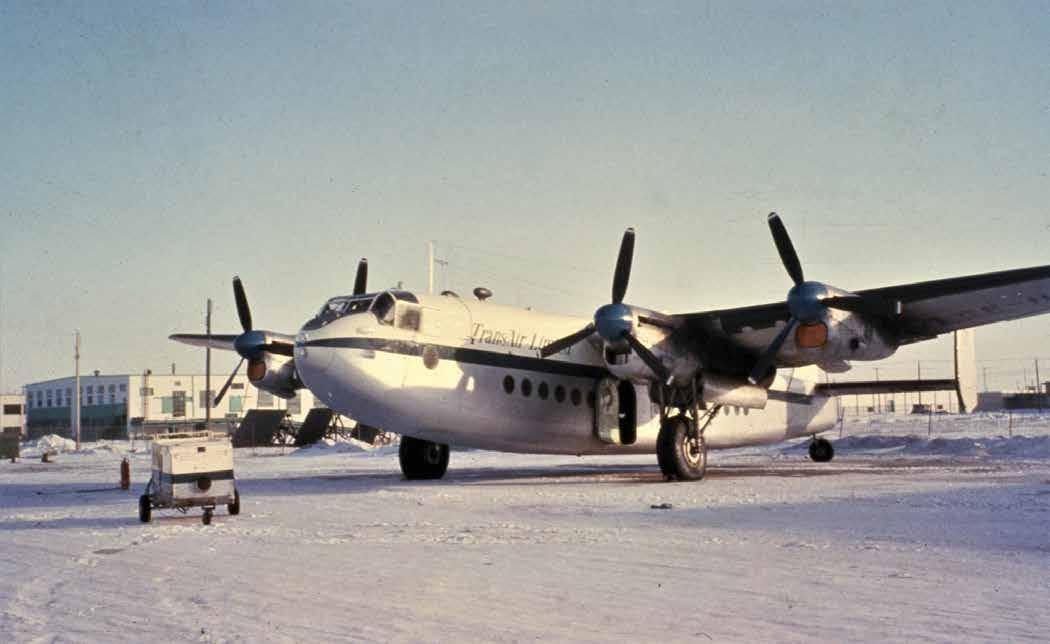
A PILOT’S LIFE LIVING THE DREAM WITH CHRIS WEICHT
PROPLINER MAGAZINE 18 CANADIAN AVIATOR MAR/APR 2024
This photo, of unknown origin, features an Avro York, CF-HAS, in service with TransAir. This aircraft is similar to CF-HMZ referred to in the text above.
was deeply concerned how this would affect his children. I told him how the event had affected me, which he seemed to appreciate. In fact, he seemed to make every effort to help me in my quest to fly for a living.
One of the PWA co-pilots had suddenly departed from the operation. Burt Sechrist, one of the American Flying Tiger contract captains, came to my room and asked if I would like to be his co-pilot on the Curtiss C-46E. He pointed out that he knew that I only had a private pilot licence, but the Department of Transport was close to a thousand miles away. As far as he was concerned, he knew that I was extremely keen, and he would help me build my time and experience. Sechrist pointed out that I would not be able to log the time in case my logbook came to the attention of the DOT. I agreed and started to learn about flying the big Curtiss. I still had to load freight and fill up the gas tanks but getting to fly and having the support of these great guys made it very worthwhile. One of the other co-pilots, however, made several complaints to Sheldon Luck and that eventually brought the charade to a halt.
Pacific Western’s C-46 activities on the DEW line was very much a bush operation. There was a radio range instrument approach at Yellowknife as well as several NDBs (non-directional beacons) along the Arctic Coast, but otherwise there were few navigational aids in the Northwest Territories.
One typical flight route was to DEW Site 10, Clinton Point, NWT, which was designated as PIN-1. The flight route would typically be flown for 261 miles direct to Sawmill Bay (SW), which had an NDB at 296 kHz. From there it was another 270 miles direct to Clinton Point NDB (UH) at 340 kHz. Or an alternative routing was via Contwoyto Lake NDB (WO) at 361 kHz, then direct to the coast and westbound to Site 10. It would typically take 2 ½ hours to fly from Yellowknife to Clinton Point.
Much of Canada’s Barren Lands and Arctic coast are located in an area of compass unreliability due to its proximity to the magnetic north pole. Of necessity, one must navigate using true north rather than
magnetic north, and all the instrument approach charts there are designated this way.
The Barren Lands are an area of featureless tundra wilderness covered by thousands of lakes and, to the north, it is above the treeline. In winter, which lasts over six months, it is in darkness and map-reading would not be possible.
Once at Site 10 we unloaded the freight and refueled out of barrels, sometimes with a powered pump but often with a hand-powered rotary pump. This often took a lot of time as the Curtiss C-46E had a fuel capacity of 1,400 US gallons. Fortunately, we loaded less than maximum fuel for the return flight to Yellowknife, one reason being that the fuel had to be flown in and its resulting cost was very high. Sometimes the weather or mechani-
“The DEW Line was built during the so-called Cold War. It was a system of radar stations set up to detect incoming Soviet bombers and provide early warning for a land-based invasion.”
cal difficulties required that we remain at the camp. If so, we slept in double-walled tents with a wooden floor and walls. There was an oil heater in each tent, and we of course always travelled with our arctic sleeping bags. Each camp had a cookhouse and even though the meals were simple there was always lots of food.
The DEW Line was built during the socalled Cold War. It was a system of radar stations set up to detect incoming Soviet bombers and provide early warning for a land-based invasion. The northern DEW Line starts from the Chukchi Sea on Alaska’s northwest coast, continues across northern Alaska and Canada’s Arctic coast as well as crossing southern Greenland. It was entirely controlled by the United States. They paid the bills, and they called the shots.
There were several Canadian airlines which had contracted with DEW Line Operations to supply air transport for the construction and re-supply of the chain
of radar stations. The primary Canadian operator was likely Canadian Pacific Airlines; however, others were Associated Airways at Edmonton, Maritime Central Airways, Pacific Western Airlines of Vancouver and others.
Sometime later, due to a slowdown of operations, we moved Pacific Western’s base from Yellowknife to Edmonton, Alberta (at the then downtown municipal airport which was known as the “Muni”) where we were housed at the Edmonton Inn. While there, I was a witness to the unfortunate fatal accident of an Associated Airways Avro York, which was heavily overloaded and never got out of ground effect and ran into a row of railway freight cars. At this time the number of flights by PWA was reduced significantly and I was returned to Vancouver and laid off.
I was fortunate in finding employment at the Department of Transport Meteorological Office at the Vancouver airport (then known as VR-AMF or Vancouver Air Mail Field) and started training as a Meteorological Assistant. After several months of training, I began making weather observations, tracked upper winds using radiosonde balloons, plotted weather maps with information obtained from freighters and passenger liners, as well as weather ships in the Pacific Ocean. This of course was long before the use of computers and weather satellites.
One advantage of this job was that I had the privilege of flying on DOT aircraft. On one occasion I flew in Beechcraft D-18S, registration CF-GXC, with inspector Bill Lavory from Vancouver to Calgary and, after an evening with his pilot friends, returned to Vancouver. (This was a job that became very useful later when I was able to resume flying for a living.)
I eventually got into a dispute with Chief Forecaster Patrick McTaggart-Cowan, who told me in no uncertain terms that he did not like pilots. (During the Second World War, this man was the chief forecaster for the Ferry Command at Gander, Newfoundland, and it was there he formed his dislike of pilots.) I told him that I did not like bureaucrats either. After a few unprintable words we then decided to go our own ways (mine without a paycheque).
CANADIANAVIATOR.COM 19
The previous article discussed the basic Lateral Navigation (LNAV) approach — it is flown with lateral guidance by following the ‘magenta line’ and honouring the altitudes as depicted by stepping down in altitude at the appropriate location. As well, a technique to manually add a vertical path was shown using a rated descent to emulate an imaginary glidepath. This article will describe the same LNAV approach with a displayed vertical path.
The LNAV/VNAV (LNAV with Vertical Navigation) approach, formerly known as a Baro-VNAV approach, is a formally designed instrument approach using specific design standards. The path over the ground is identical to the LNAV approach. However, a glidepath, based upon barometric altimetry, is considered in the procedure design.
Owing to the challenges with barometric altimetry (non-standard atmosphere, etc.) a temperature limitation is imposed upon the procedure as the slope of the protected surface beneath the glideslope changes with temperature. This is shown in the depiction — if the airport temperature is within the published bounds, an approach is authorized using LNAV/VNAV. An observant pilot will notice that despite being a nominal 3° glideslope, the true flight path angle will vary with the temperature — a warmer than standard atmosphere will result in a steeper approach angle (and lower than normal engine power) and a colder than standard atmosphere will result in a flatter approach angle (and higher than normal power).
In general, the LNAV/VNAV approach produces lower approach limits than the LNAV approach; years
INSTRUMENTAL FACTS FLYING IFR WITH ED M c DONALD
LNAV
Source of Canadian Civil Aeronau tical Data: © 2023 NAV CANADA A ll rights reserved CYOW-IAP-3G 0 5 10 15 20 25 (NM) CYOW-IAP-3G OTTAWA/MACDONALD-CARTIER INTL, ON RNAV (GNSS) Z RWY 32 451921N0754002WVAR 14°W CYOW ATIS – 121.15 (En) 132.95 (Fr) ARR – 135.15 TWR – 118.8 GND – 121.9 SAFE ALT 100 NM 7000 WAAS Ch 80163 W32A APCH CRS 320° MIN ALT VODUL 2000 LDA 10005 CATEGORY A B C D LPV 567 (200) ½ RVR 26 LNAV/VNAV (min. -19ºC, max. 54ºC) 654 (287) 1 RVR 50 Knotsft/minMin:Sec 70370 LNAV 760 (393) 1 RVR 50 90480 110580 130690 150800 RNAV (GNSS) Z RWY 32 CYOW EFF 24 MAR 22 EFF 24 MAR 22 EFF 10 OCT 19 Canada Air Pilot Effective 0901Z 10 AUG 2023 to 0901Z 5 OCT 2023 NOT FOR NAVIGATION PURPOSES 20 CANADIAN AVIATOR MAR/APR 2024
+ Displayed Vertical Path HIGHLY ADVANCED APPROACHES MAKING THEIR WAY INTO GA PANELS
ago, the opposite was true and this was due to a quirk in the design criteria which has since been corrected.
In both cases of the LNAV and LNAV/VNAV approach, a temperature below 0° Celsius requires a temperature correction applied to minimum altitudes. Unlike the LNAV approach, however, a slight altitude loss when transitioning from the descent to missed approach is permitted as the missed approach design accounts for this.
The LNAV/ VNAV approach was originally intended for aircraft with Flight Management Systems (FMS) like those found on airliners and business aircraft. This type is available for general aviation aircraft in certain avionics. If Satellite-based Augmentation System (SBAS) is available, an LNAV/VNAV approach can be flown since a highly accurate altitude is available to the avionics. Consult your owner’s manual as different avionics have different restrictions.
“The LNAV/VNAV approach was originally intended for aircraft with Flight Management Systems (FMS) like those found on airliners and business aircraft. This type is available for general aviation aircraft in certain avionics.”
LNAV+V types of approaches that pilots must be aware of. All formally designed approaches with vertical guidance (LNAV/VNAV, LPV, ILS) are assessed for the area between the Decision Altitude (DA) and the runway for any obstacles beneath the approach path. In other words, with these approaches the pilot is assured that no obstacles will affect them as they transition to land; this is not the case of an LNAV approach with the vertical path added, using either the Stabilized Constant Descent Angle (SCDA) method in the previous article or the avionics provided guidance with an LNAV+V.
Some avionics provide a displayed vertical path with an LNAV only approach. Depending on the avionics, it may be identified differently. With the popular Garmin avionics, it is displayed as LNAV+V. In these cases, the database provider, Jeppesen for example, adds a vertical path to the approach by taking the runway elevation, adding a threshold crossing height, then projecting a glidepath (typically 3°) into the approach area. With both the LNAV+V and LNAV/VNAV style of approaches, the actual altitude of the aircraft is compared with the calculated altitude — the vertical display shows the deviation above or below this path.
There are significant differences between the LNAV/VNAV and the
A number of years ago a business jet had an “excursion” through some trees during a dark and stormy night; they flew the approach by the book, broke out of the clouds and continued on the vertical path to the runway not knowing that the visual segment of the approach was not free of obstacles as it was not an LNAV/VNAV approach (with the visual segment properly assessed), but an LNAV approach with the vertical path added.
Aircraft with GPS-only capability can fly instrument approaches to a high degree of accuracy with improved situational awareness. With either the SCDA technique or a computer-generated vertical navigation display, the traditional dive-and-drive has been replaced with a vertical path that significantly improves flight safety.
In my next article I will discuss the new, gold standard of approach navigation, Wide Area Augmentation System (WAAS) and the associated Lateral Procedure with Vertical Guidance (LPV) approaches.
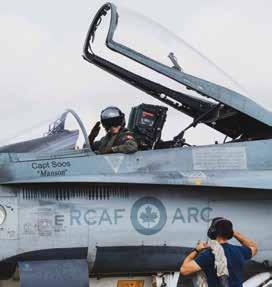
For more information, contact KATHERINE KJAER 250.592.5331 katherine@canadianaviator.com CANADA’S MOST POPULAR AVIATION NEWSSTAND TITLE MAR/APR 2023 $6.95 CANADIANAVIATOR.COM RCAF Returns Home The AI & Flight Training COMPUTER-ASSISTED INSTRUCTION FPET Project PIETENPOL WINS AT AIRVENTURE Passionate about aviation, we engage, educate and entertain — which is why each issue of Canadian Aviator is read cover to cover and passed along to business associates, fellow pilots and friends. Advertise in the best-selling aviation magazine on newsstands in Canada
CANADIANAVIATOR.COM 21
Want to Cancel IFR?
SEVERAL THINGS YOU NEED TO CONSIDER

What does it mean when a pilot cancels IFR? Do you know all that is involved with that phrase, what it means to ATC, and what’s left for you, as a pilot, to do?
When flying IFR, ATC is responsible for separation between you and other IFR aircraft. In some airspaces, such as Class B airspace, it may also include separation from VFR aircraft. In most airspace in Canada, VFR are not included in that equation as most is Class E controlled airspace where VFR isn’t subject to ATC clearances and instructions or Class G uncontrolled airspace, where no aircraft is subject to ATC.
In both E and G airspace, VFR pilots don’t have to talk to ATC and controllers may not even be aware of the presence of VFR aircraft.
So let’s look at this with respect to IFR aircraft and that final portion of an IFR flight: the approach to an aerodrome. As long as the pilot continues on an IFR flight plan with an IFR clearance in controlled airspace (in this case, a control
zone which reaches to the ground), ATC will assign tracks, altitudes or approach procedures as required and keep the separation between IFR aircraft.
Why would a pilot want to cancel IFR and give up ATC-provided separation?
Sometimes the weather is good at destination and a pilot doesn’t want to fly the extra miles downwind on an RNAV procedure or do a procedure turn to join final. Sometimes a pilot would prefer to conduct the approach visually, since flying into the traffic pattern without those extra miles saves flight time, fuel and bother in flying instrument procedures.
With no other traffic involved, such as an IFR departure with a departure clearance, ATC can usually permit this when a pilot requests either a visual or a contact approach. If departing traffic is involved, these may not be options.
Also, anyone who flies IFR regularly knows a variation of the old joke, “What does IFR mean?” with answers something along the lines of, “I fly restric-
tions.” Those restrictions are used to ensure separation, and they can be quite restrictive, especially in airspace not covered by surveillance systems.
This means that a departing IFR aircraft may have to wait on the ground for a period of time for an arrival to land. Strictly in terms of the IFR clearance, the departing aircraft would no longer have to wait for the arrival if the arrival is no longer IFR. Thus, a pilot cancelling IFR on approach allows the departure to take off perhaps much sooner than the clearance might otherwise permit.
So what does this mean to the pilots involved?
At this point, I’ll make an aside. The pilot who cancels IFR is still required to file an arrival message to close the IFR flight plan just as if the flight were still operating on a clearance. This is done automatically on a pilot’s behalf if landing where AAS (Airport Advisory Service) or RAAS (Remote AAS) is provided by FSS or where a control tower is operating. Otherwise, the pilot
VECTORS ATC VIEWPOINT WITH
MICHAEL OXNER
22 CANADIAN AVIATOR MAR/APR 2024
must close the IFR flight plan via phone or through direct contact with the controller on a radio frequency, if available. Closing the flight plan may be done while still in the air, but the pilot should be aware that this stops ATC-provided alerting services, too.
Back to the recently cancelled IFR flight. The pilot is required to avoid other traffic, including VFR aircraft, operating around the aerodrome, just as before, and also the departing IFR aircraft.
A fairly common issue faced by pilots exists at single-runway airports whose configuration has only one or two taxiways, perhaps only at one end of the runway. For the sake of expedience, an arriving aircraft may elect to land on one end, and later wish to depart in the other direction to reduce taxi time. This leads us to planned departures wishing to take off into the approach path of arriving aircraft.
Because one of the aircraft is no longer IFR, ATC in the IFR ATC unit (usually the Area Control Centre) is not required to provide separation between the IFR departure and the now-VFR arrival. A clearance issued to a departure will not normally include provisions for said departure to manoeuvre around the arrival’s path because ATC no longer has authority over the arrival’s path.
When an arriving pilot cancels IFR to permit an IFR departure to take off, it is now incumbent upon the pilots to stay away from each other, and consideration must be given to a lot of things; most importantly, the timing of the IFR departure and the flight path assigned to that departure.
If the arrival is established on, or just planning to fly, a straight-in approach to landing and the departure is assigned or permitted a straight-out departure in the opposite direction with the IFR clearance, things can get tense quickly. Such
a situation may require the arriving aircraft to alter course to allow for the departure. Given the closure rates, this decision may have to take place early and quickly to avoid a nose-to-nose situation.
In most of these cases, ATC’s last ability to prevent an occurrence is removed when a pilot cancels IFR and, once that happens, the only thing left for a controller to do is provide traffic information. When these occur near airports, enroute ATC may be out of the communications loop since the aircraft will be on the mandatory frequency (MF) or aerodrome traffic frequency (ATF). That means the information will have to be derived from other sources such as FSS, where available, and/or other pilots.
While cancelling IFR can help move airplanes, caution should be used by pilots to ensure everyone knows what’s going on and that plans of action don’t lead to hazardous situations.




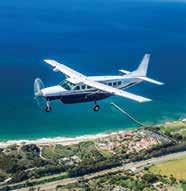

SUBSCRIBE AND SAVE ONE YEAR SUBSCRIPTION $26 (TAXES MAY VARY BY PROVINCE.) 1.800.656.7598 canadianaviator.com CANADA’S MOST POPULAR AVIATION NEWSSTAND TITLE QUICK SUBSCRIBE! RENO AIR RACES De Havilland’s Dragon Rapides THE MULTIROLE BIPLANES MADE THEIR MARK IN CANADA Fighting Wildfires THE ROLE HE PLAYED +Liberator Overdue BRITISH-CREWED AIRCRAFT DISAPPEARS IN B.C.’S MOUNTAINS The Curtain Falls on Iconic Championship Event CANADA’S MOST POPULAR AVIATION NEWSSTAND TITLE MAY/JUN 2023 $6.95 New Columnist: INSTRUMENTAL FACTS Supporting the Canadian Mining Industry HOW AVIATION PLAYS KEY ROLES +BrittenNorman’s Trislander ODDLY EQUIPPED FOR MINERAL EXPLORATION ANTONOV’S BACKCOUNTRY BIPLANE Aerial Yachting in Style GRAND CARAVAN An easy-to-fly modern workhorse QUICK SUBSCRIBE! J. Errol Boyd NEWFOUNDLAND’S INTREPID AVIATOR The Mystery of Roderick Island UNSOLVED 54 YEARS LATER +The 54th Salon du Bourget WE REPORT FROM PARIS CESSNA’S CANADA’S MOST POPULAR AVIATION NEWSSTAND TITLE MAR/APR 2023 $6.95 RCAF Returns Home The AI & Flight Training INSTRUCTION FPET Project PIETENPOL WINS AT AIRVENTURE BEECH’S STAGGERWING 90 years young – and still turning heads I Flew the Vulcan Bomber ON ONE ENGINE! CubCrafters Adopts a Rotax Designing Instrument Approaches WE TAKE YOU THROUGH THE PROCESS $7.95 CANADA’S MOST POPULAR AVIATION NEWSSTAND TITLE JAN/FEB 2023 $6.95 Stamp Duty Canada Post Stirs the Pot HAWKER HURRICANE Battle of Britain Workhorse Team Canada AT 2023 WORLD AEROBATIC MEET Ski-Flying ENJOY YOUR PLANE YEAR-ROUND Airbly Phoenix LOGGING-TRACKING + CANADIANAVIATOR.COM 23
GA’s Role in Maritime Searches
EVEN CESSNA 172 s HAD THEIR PLACE
Looking outside yesterday, the area where my wife and I live was blanketed in snow. Before six or seven years ago, that blanket could have been as much as a metre deep. But yesterday, light powdery snow about three centimetres deep was the case as it has been for these last six or seven years. Global warming?
Later that evening I thought back to my early years when snow in the winter was always deep. Then, unbidden, the memory of a Civil Aviation Search and Rescue Association (CASARA) search popped into my head. We were District 2, Halifax. I was Zone Commander then. We had two Cessna 180s and three Cessna 172s in our group. It happened that on Sunday November 22, 1987, I had planned an exercise practising track crawls. Kevin Layden and I had found a couple of open spaces in the woods some 15 miles from — you guessed it – Stanley Airport. We laid down orange tarps in the shape of small airplanes. Long story short, the exercise was well attended, and the crews were successful. I got to sit in on this one and man the radios.
When we began our search, I contacted the Rescue Coordination Centre (RCC, now JRCC) to advise them we had an exercise in progress just in case we could be of service. I was thanked and then we disconnected. I was surprised when not 10 minutes later they called back and advised me that they might require our services the next day. Could I have an aircraft on standby? That was a Monday, a workday. I knew I was available but that was all. I told them I would check my members and, if memory serves, I recalled one of the aircraft I had was searching for tarps. There were two C-172s and one C-180, all four-seat aircraft. From those three crews I was able to get three people who could commit to the next day if required. Kevin Layden, a pilot of his own homebuilt Rand KR-2 plane at Stanley and a radio operator for the Coast Guard, was available. Layden was our CASARA navigators training officer. The two spotters in the back seat were James Walker and
Marc MacPherson. Mike Doiron, who worked for Transport Canada, replaced MacPherson for our afternoon search. At 5:30 the next morning, RCC contacted me at home and tasked me to arrive at Halifax international airport (CYHZ) for briefing. I contacted Layden and he contacted the two spotters. Layden would then meet up with me and we would head up to Stanley to fly my plane to CYHZ.

As it turned out, it had snowed overnight and the temperature about 5 Celsius. When we arrived at Stanley there were small snowdrifts around, preventing me from getting my Cessna from its hangar to Runway 27/09. And even if we could, the runway seemed to be covered with a 15-centimetre layer of powdery snow with a slushy underlay. Although the snow had stopped, it was a grey day with a high overcast.
The province of Nova Scotia maintained a heavy equipment maintenance facility in the southern third of the World War Two hangar that still stood there. The mechanic, Bill Ward, was there and used a front-end loader to clear us a path from the hangar to the centre taxiway to Runway 27/09. The Cessna taxied well enough through it, so we continued to the east end of the 2,400-foot-long runway. So far so good. I lined up with the ruts the landing gear wheels had made on the back-track, did another run-up, added flap and asked Layden to alert me when we were about to pass the centre taxiway. If we weren’t airborne by then I would abort.
I firewalled the throttle. The prop bit into the cold air and pulled us forward. I kept my eyes on the runway, attempting to stay in my tracks. Eyes flicking between the view forward and my instrument panel, I was expecting Layden to call out at any second but, before that happened, we lifted off and climbed swiftly away to the west and
then turned southward for Halifax airport. It was a short trip of only 40 kilometres. I contacted Halifax Radio, informing them that we were inbound and to please inform tower. When I called tower at the edge of their zone, the controller ‘rogered me’ then informed me that we were designated as Rescue *** (the last three call letters then of my long-since-sold airplane). We landed on Runway 24 and were directed to Taxiway Echo, handed off to Ground and directed to the west end of the apron. After shut-down we were taken to a room for our briefing. RCC had informed me the day before that there might be a fishing boat missing; the officer briefing us now filled in the details. The skipper of the small fishing boat, Captain Barrenger was worried that a six-metre-long net he and his two sons had left deployed somewhere off the southwestern coast of Halifax County might be lost to heavy seas that were expected later that evening. The three fishers and their vessel were now officially missing. Our task would be to ‘drag’ the coastline from Indian Harbour to Ketch Harbour some 60 nautical miles if you included all the little bays and inlets. We would be looking for any sign of the vessel and its crew of three. It would be no easy chore.
We arrived off Indian Harbour, which was to be the western end of our search area, and I set a course just offshore at a thousand feet and we made the coastline crawls while MacPherson (the spotter) and navigator Layden scanned the ocean on the eastbound track and then the shores on the return track. Then we would move ahead to the next sector and do the same thing. At times I would go inland a short distance to
DOWN EAST ATLANTIC FLYING WITH DON LEDGER
24 CANADIAN AVIATOR MAR/APR 2024
The search area had similar features as depicted in this photo.
allow the spotters a different perspective, although the land from the shoreline was featureless covered in what looked like flat white snow.
At some point out over the ocean, MacPherson spotted something sticking out of the water. We went over to explore it. I reduced altitude to the allowed minimums and circled what appeared to be perhaps two metres of the bow of a boat pointed straight up. Layden was handling the radio work and contacted the coast guard on a special aviation frequency and reported what we were observing. They contacted one of their vessels to go there and investigate. We learned later that it was some four hours before they would arrive there and found nothing.
After three hours of searching, we returned to YHZ to debrief and to refuel the plane and ourselves. I grabbed a half-hour nap then we were out again to continue our search. We had to replace MacPherson with Mike Doiron, who was one our CASARA spotters who worked at CYHZ’s Flight Service Station as it was called then. We could only do just under two hours, return our spotters to CYHZ and then fly ourselves and the plane back to Stanley before Sunset. Landing was uneventful.
After we arrived back in the city, I flopped on the living room sofa and dozed off. Layden called and asked me if I was really tired, saying that, like me, he could not believe how much the search had taken out of him. We discussed that for a while. Shortly afterward, the phone rang again. This time it was RCMP Constable Doug MacKinnon, another Stanley pilot. He asked if I had been on a search that day because he had seen my plane flying over a news camera in Indian Harbour. I explained what we had done. I remarked that I was concerned that morning about using the runway and how much I would use to get airborne. I figured we were off by the centre taxiway, which is 1,200 feet from the east end off Runway 27/09. He explained that he had walked out there, and the Cessna had lifted off in half that distance.
To my knowledge the Berrenger vessel was never found, nor was its crew. Three lives lost for 20 feet of fishing net.

CANADIANAVIATOR.COM 25
Off-Airport Landings
WHERE WOULD YOU CHOOSE?
Afew weeks ago, a Piper Comanche lost power over a highly congested suburb of Paris, France. With few options available, the instructor pilot aimed between two buildings, and crash-landed just short of another one, losing wings and tail in the scuffle. When everything stopped, the instructor opened the door of the intact aircraft cabin, stepped out, and then helped his two students out.
On occasion, we see spectacular crash landings with stunning decisions and outcomes. The most widely publicized occurrence was the “Miracle on the Hudson,” featuring the pilot’s daring and successful choice of water over land.
When it comes to picking THE spot, the standard recommendations are airports, roads and then large open fields. Unfortunately, the conversation often stops there unless the training area presents a specific challenge to finding the recommended options. Regardless of where we train, we spend much of our flight time in and over diverse landscapes that are rarely emergency-landing friendly. Thinking through viable scenarios ahead of time can serve us well should the unthinkable happen.
For example, I learned to fly at a boxed-in airport where “land straight ahead” after departure meant staring at residences from the end of the 5,000foot runway onward. In the event of total power failure below 300-400 feet from the ground, options were blinked. We would have been ill-equipped with just a “land straight ahead” recommendation. So, the school’s chief instructor shared his contingency plan: aim between two houses to shear the wings off, remove the fire risk, and cushion the deceleration. That might sound a little wild at first, but it was a realistic, survivable strategy for that airport.
While roads and their appealing

runway-look may seem like viable solutions in built-up areas, looks can be deceiving. Road lanes are 3 to 3.7 metres wide in North America and as narrow as 2.7 metres in Europe. They are adequate for cars, but even a small Cessna 172 has an 11-metre wingspan. Sully’s Airbus A320 had a 34-metre wingspan. Needless to say, most highways cannot accommodate airliners, and few encased roads can accommodate small aircraft. Alleys are even narrower, so they may serve only as a strategy to shear the wings off. It takes nerves of steel and precise directional control to pull that off.
Large open fields are usually plentiful in flatlands and remote areas but sparser in congested areas. The minimum size for an adequate landing field depends more on the approach to the field than on the ground roll distance available. For example, a C-172 requires as little as 500 feet from touchdown to full stop on drag-free surfaces under favourable density altitudes. However,
it requires 2-1/2 times more to clear a 50-foot obstacle during the approach under the same atmospheric conditions. When open fields are few, searching for obstacle-free approaches to open areas should take priority over field size. Hitting an obstruction at the end of the ground roll is preferable to dropping in from 50-plus feet after hitting something at approach speed.
Flat land free of obstructions is preferable but not always available. Much of the Earth’s land is mountainous or covered with trees, sometimes both.
Mountainous areas present a very challenging environment. Although some mountainous areas come with welcoming valleys or plateaus, others only feature sharp slopes and narrow canyons. The only hope for survival in the latter case is to ensure that the aircraft comes in contact with the surface “feet first,” no matter the surface angle.
Tree-covered surfaces are not created equal either. Landing in an orchard
RIGHT SEAT ALWAYS LEARNING WITH MIREILLE GOYER
26 CANADIAN AVIATOR MAR/APR 2024
The pilot walked away from this Cessna 172. EMELIE PEACOCK/HOPE STANDARD
“When considering offairport landings, thinking outside the box begins with accepting that the comfortable options might not be available.”
is less hazardous than landing on an ancient forest. The tallest tree in Canada is a Sitka spruce located in the Carmanah Valley of Vancouver Island. It measures 315 feet. The widest Canadian tree has a 20-foot (6-metre) diameter. Mammoth-sized trees are not unique to British Columbia. They also call Northern California and other areas across the globe home. Forests have a velvety carpet look from a bird’s eye viewpoint, but they are far less visually welcoming up close. When faced with landing on tree canopies, density is the key criterion. The denser the treetops are, the higher the chances tree limbs will serve as a safety net for the wandering bird.
The most common surface on the Earth is water, whether as a river, lake, or sea/ocean. The approach is rarely the challenge in that case; the touchdown and evacuation are. A high sink rate upon touchdown spells trouble, especially for aircraft with extended landing gear. The wheels will dig in and likely cause the plane to flip over, rendering evacuation of the aircraft challenging. Upside down in the water for low-wing aircraft translates to a cabin submerged under the wings. Although touching down as slowly as possible is essential, dropping in is far more hazardous than momentarily ‘water skiing’ with a negligible sink rate.
When considering off-airport landings, thinking outside the box begins with accepting that the comfortable options might not be available. Then, the rules of survivability must prevail: maintain control to touchdown on the wheels or belly, the most robust structural part of the aircraft, as slowly as possible, even if that means giving up limbs to cushion the deceleration.
The Airline-Style Pre-Flight Briefing
IT’S FOR THE LITTLE GUYS, TOO
If you’re reading this column (let alone this magazine), you’ve probably flown in a small aeroplane before. Furthermore, you’ve probably flown commercially, too, and sat through the pre-flight passenger briefing, albeit paying scant attention to the airline’s fulfillment of its legal requirement to tell you how to fasten a seatbelt, don a lifejacket that’s somewhere under your seat, breath into a plastic cup tethered to the ceiling, or find your way out of a smoldering wreckage. The process can seem a little bit pedantic, not least for frequent flyers. But it’s written into the Canadian Aviation Regulations (as CAR 602.89) that it must be done. However, it’s not just necessary for the airlines to do this. If you’re a frequent flyer who is pilot-in-command of your own aircraft, it’s incumbent on you to do the briefing when you’re taking passengers along for a ride.
Each time your aircraft carries passengers, you are required to provide a briefing. Any passenger with special needs – which could include someone who is visually or hearing impaired, or an adult with an infant – should receive individual attention attuned to the specifics of their circumstances. Safety briefings should describe to passengers where to locate emergency equipment, and how (and when) to use such equipment. And passengers should be advised when it’s acceptable to talk to the pilot, and when it’s not.
For starters, and before every takeoff, passengers must be informed of the location and use of normal and emergency exits and windows. Some small aircraft have doors, while some have sliding canopies. Some doors open upwards instead of forwards, some canopies slide forward instead of backwards. And few aircraft have common latching mechanisms. A
demonstration of how your aircraft doors and windows operate and latch will be necessary for any passenger new to your aircraft. For someone who is a recurrent passenger, the briefing will serve as a useful reminder to those who may only seldom come along for a flight.
Also, if you’re the owner of an aircraft that has an escape hatch built into the cockpit, it’s best to identify its location to passengers should an accident pin the doors closed, preventing any egress. Furthermore, such aircraft may also have a mallet-like device hidden away that can be used to bust the latch open for a getaway. Let passengers know where to find such a hammer, the use for which can not only be to break through a hatch, but also to break a window if, in the event of an accident, that’s the only way to get out. And don’t forget that, should other options fail, the location and operation of doors for luggage and/or cargo should be described for passengers. As a last resort, they are a way out, too.
Passengers need to be told (or reminded) about seatbelts and how they are to be used. Be sure that passengers detach and re-attach their seatbelts for familiarity, and be additionally aware that, for aircraft that may have four-point harnesses, passengers may be clueless as to the functionality of the buckle into which the four belts are secured. Make them trial the mechanism a few times to ensure that they are comfortable with its operation. It goes without stating, too, that passengers should be told that seatbelts should be fastened securely for takeoffs and for landings, for turbulence and for any emergency situations that may arise.
CAR 602.89 requires that passengers in a helicopter or a small aeroplane be informed of the location and operation of the emergency locator transmitter (ELT).
PEP TALK AIRMANSHIP WITH GRAEME PEPPLER
CANADIANAVIATOR.COM 27
An explanation of the device’s purpose, its auto-transmit feature in the event of a sudden deceleration, and its manual “switch on” feature needs to be explained.
Additional items requiring explanations include things like the positioning of seats, seat backs and chair tables; the location and use of an onboard fire extinguisher; the location and use of a first aid kit and survival gear; where to locate life jackets and life rafts for overwater flights; any policies with respect to the use of portable electronic devices; and how to stow carry-on baggage. And any passenger who may think it’s wise to smoke (or vape) in an aircraft needs to be told the limitations of doing one or the other.
For an aircraft that is unpressurized, passengers need to be told how to use the supplemental oxygen system, if equipped, should it become necessary. For a pressurized aircraft, passengers must also be so informed if the aircraft is operated at an altitude above FL250.
Any briefing should explicitly explain to passengers what actions to take in the event of an emergency: baggage and any loose items must be securely stowed including any sharp objects, seats must be upright and seatbelts must be tight. The passenger next to a door must be briefed on how to open the door when told to do so, and they need to be told that this command may occur before the aircraft touches down in an emergency landing.
Finally, if your aircraft has a ballistic parachute, show the passengers the handle to pull to activate it. If you’ve got Garmin’s Autoland feature in your aircraft, show passengers the button they need to push to engage it. If you’re incapacitated, they’ll need to know how to activate these lifesaving features. Thereafter, once you’ve exhausted yourself (and your passengers) with all these pre-flight instructions, don’t forget to tell everyone now in readiness for the flight to sit back and enjoy the ride.
Gander to Sweden in a Monoplane 90A
SWEDE DEPARTED GANDER THEN DISAPPEARED
By mid-1939 most noteworthy conquests of the Atlantic Ocean by air were already in the history books; their principals hailed as heroes to a greater or lesser degree. The fortunate ones lived to enjoy their celebrity while others found notoriety for having given their lives in the quest for aviation fame and fortune. With war clouds on the horizon which most people believed, correctly, would shortly mature into the hell of the Second World War, it seemed an odd time to be attempting such a risky adventure.
So it caused some consternation in the central Newfoundland town of Gander, site of the then-largest airport in the world, when a young Swede, who had been living in the United States for over a decade, touched down at the newly constructed airport on May 15, 1939 with the intention of making the Atlantic crossing in a small, single-engine aircraft with the stated purpose of “not having to paint houses anymore” and a desire to put his native Sweden in the aerial record books. Within 24 hours he had taken off on his Quixotic journey and would be assumed lost days later. His fate would remain just another unsolved mystery of the Atlantic until a ghostly clue surfaced four months later.
Researching the story of Charles Backman (Carl or Charles Bachman in some accounts) proved challenging as he appeared to have attracted little or no attention in the aviation world. A brother, Andrew, told the press Backman was a “good aviator” with a reported 1,500 hours of flight time but that the attempt was “too risky.” Nevertheless, Andrew and second brother Gustbeck remained confident that their sibling would fulfill his dream.
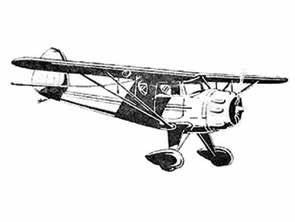
“I’ll never swing a paint brush again,” Backman was reported to have said before his departure. “If I make it, life will be good to us. If I don’t, I won’t need work.”
As a further indication of his confidence in success, Backman was reported to have given a diamond ring to a lady named Letitia Lentz. But when questioned by reporters following his loss, she insisted that they were not engaged.
Then began the ritual newspaper stories over the next few days saying he was overdue, had not been sighted or heard from (his aircraft carried no radio) and that he was presumed lost over the trackless northern ocean. A public appeal containing a detailed description of his plane asked any person between Gander and the coastal community of Cape Freels to report any sighting of the plane or of hearing an aircraft engine passing by. The appeal quickly drew one response in a message from the community of Newtown, Bonavista Bay, that the plane had been seen passing over about 90 minutes after its takeoff time of 5:30 am. Days later, on May 22, a further report indicated other sightings raising the possibility that Backman may have decided, in view of the poor weather then blanketing his intended route, to turn back and had become lost in an attempt to return to Gander. News reports of the time make no further mention of sightings and whether or not said sightings were genuine is not recorded.
Adding to the fears for Backman’s safety was the aircraft he chose for his
ON THE ROCK
AVIATION WITH GARY HEBBARD
NEWFOUNDLAND
Illustration of the plane Backman flew on his illfated Atlantic crossing.
PEP TALK (continued) 28 CANADIAN AVIATOR MAR/APR 2024
attempt. The Lambert Series 90 Monocoupe, a high-wing monoplane powered by a five-cylinder, radial engine of just 90 horsepower, was well regarded and considered reliable by that day’s standards. But many seasoned aviators believed the plane was too slow and fragile for the stresses of a trans-Atlantic flight. Built just four years earlier, the plane was painted a bright white and carried the registration SE-AGM in large letters on both sides of the fuselage, suggesting the little craft should have been easily visible if being searched for.
But no physical trace was ever found on either land or ocean.
to touch down and the first to take off from the airport on a trans-Atlantic flight attempt.
“... many seasoned aviators believed the plane was too slow and fragile for the stresses of a trans-Atlantic flight.”
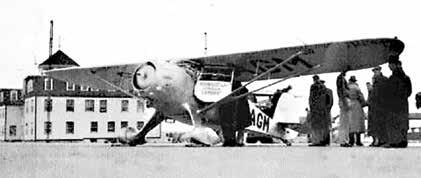
Backman also seemed rather cavalier in his preparations for the flight. He carried only some sandwiches and a thermos of tea in the overloaded aircraft. One news report indicated he even threw the sandwiches out of the aircraft before takeoff to lighten the load. There was no mention of survival gear being aboard the plane and the fuel capacity of 160 gallons was questionable. Still, Backman seemed confident and anxious to make his mark on history.
Ironically, in a small way, he succeeded before he ever took off. The airport at Gander had been completed just a year before and was meant to be a strategic base for military aircraft with the threat of war hanging over the world. The very first landing at the newly completed facility had been made on January 11, 1938, by native Newfoundland pilot Douglas Fraser flying a Fox Moth aircraft carrying registration VO-ADE. Backman, according to records of the time, is listed as the first pilot from outside Newfoundland to land there, the first American aircraft
From late May to September of 1939, Backman was considered lost in unknowable circumstances, possibly over Newfoundland but more likely somewhere in the frigid waters of the North Atlantic. That assumption would be cast into doubt when, on September 13, 1939, an American newspaper published a short but startling story. Datelined Stockholm, Sweden, the report stated that a bottle known to have been aboard the aircraft (unconfirmed) containing a penciled note had washed up on the coast of Norway. An unnamed customs officer at the Swedish/ Norwegian border said the enclosed message was signed by Backman and told of a crash landing in mid-ocean. It went on to say he would be “lost” if not rescued within three days.
Many a bottle containing messages have washed up on many coasts over the years, some ultimately proven to be legitimate, some that proved to be cruel hoaxes and some that were nothing more than a child’s whim. The press of the day makes no further reports of attempts to establish its authenticity and so the fate of a young pilot whose claim to a page in aviation history is limited to mere hours is unlikely ever to be expanded. War had already shattered world peace by the time of the bottle was found and there was no further mention in the daily press of an unknown and perhaps overconfident young pilot’s disappearance. But Charles Backman can claim, if not a page, at least a legitimate footnote in the aviation history of Newfoundland.
Get great article suggestions and post alerts when new issues become available.

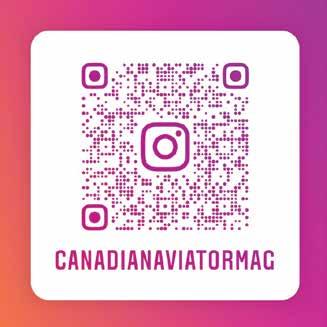 Backman prepares his plane for his attempt at a trans-Atlantic flight from Gander, Newfoundland to Stockholm, Sweden.
Backman prepares his plane for his attempt at a trans-Atlantic flight from Gander, Newfoundland to Stockholm, Sweden.
YOU FOLLOW US ON INSTAGRAM? CANADIANAVIATOR.COM CANADIANAVIATOR.COM 29
DO
Get ‘er Done!
WAS IT LEGAL? PROBABLY NOT
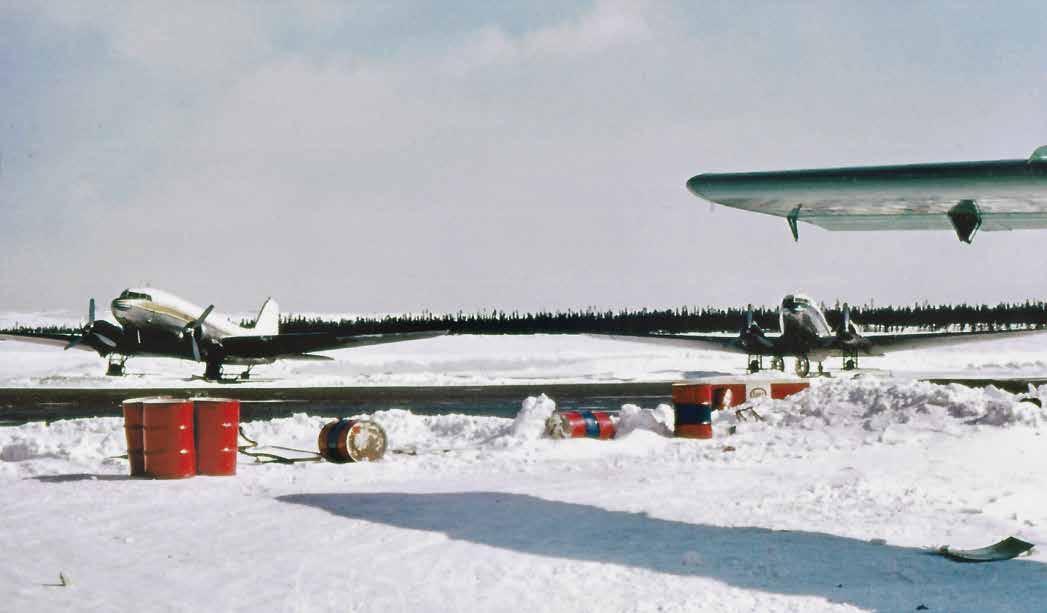
Get ‘er done” is the bush pilot’s mantra. Get the job done and just do whatever it takes. This is often the work ethic of the bush pilot when flying on his or her own in remote locations. This is the spirit and attitude that has traditionally provided aerial transportation to remote locations and has helped to service remote communities, the mining and exploration industry, forestry, tourism, the hunting and fishing industries, scientific studies, medivac services and all the other genres that require an aircraft to provide its wilderness transportation needs.
Overloaded aircraft, bad weather (requiring nap-of-the-earth flying), high winds, short lakes, challenging surface conditions (rough water, glassy water, fast flowing rivers, snowdrifts, deep snow, slush, etc.), cold weather operations, smoke, long duty days,
poor aircraft maintenance, poor living conditions, insects, external loads (including refrigerators, mining equipment, plywood, etc.), demanding customers and a host of other issues that were, and are, the considerations that face the northern pilot. Is it safe? I hope so. Is it legal? Probably not. What will the insurance companies do in the event of an accident? Will the company, or owner, back up the pilot who is ultimately responsible? Probably not. A couple of examples from my memories follow.
In the early 1970s there was a fire at one of Labrador’s northern coastal communities and the village’s food supplies were destroyed. Food replacements, including fresh fruit and vegetables, were trucked to Sept-Îles on the north shore of the St. Lawrence River, and Laurentian Air Services was chartered to fly the resupply to the village in a wheel/ski-equipped
DC-3 freighter. This aircraft had been purchased from the French Army who had operated the aircraft in North Africa. As the aircraft had been operated in a hot climate, all the heating equipment had been removed from the aircraft to reduce its gross weight and to increase its payload. Needless to say that, when this aircraft was used to transport perishable goods in sub-arctic winter conditions, the fresh fruit and vegetables arrived in a frozen state. I was tasked to find a way to warm the cabin to protect this precious cargo. My solution was to hang tarpaulins in the front and rear of the cabin and to string a cable from the interior roof of the aircraft. I then hung a series of catalytic camping heaters from the cable. These little glowing fire pots warmed the cabin to above freezing and the villagers received their fresh produce in good condition. Was the solution
COLE’S NOTES CAREER HIGHLIGHTS WITH W.T. (TIM) COLE
“
30 CANADIAN AVIATOR MAR/APR 2024
ALL PHOTOS: COLE COLLECTION
effective? Yes. Was it safe? I thought so or I wouldn’t have done it. Was it legal and did it meet airworthiness standards? Probably not. Did we “get ‘er done?” Yep!
In late September 1971 there was an early freeze-up on the Northern Quebec/ Labrador border. We still had caribou hunters out in the bush. Helicopters were not available, and we needed to get these folks out fast. Our home base lake was open but the lakes at higher elevations were freezing fast. How much thin ice can you land a floatplane on without damaging the floats? Has it been done before? “Oh yes,” advised the old-timers. “So just get ‘er done!”
The photo on this page shows my single-engine Otter picking up the hunters with about two inches of ice clearly showing on those portions of the ice that had not been broken through. The next decision was, do you take off with a loaded airplane in the semi-open water where you had just landed, or do you pick a fresh piece of ice to attempt the takeoff? Which choice would do less damage to the bottom of the floats and which choice provided the minimum
“...do you take off with a loaded airplane in the semi-open water where you had just landed, or do you pick a fresh piece of ice to attempt the takeoff?”

risk of ripping a float open and sinking? I chose the first option and took off in the channel where I had already broken the ice, although the latter part of the takeoff run, when nearing flying speed, was up on top of the thin layer of ice. I “got ’er done!”
These are just two examples of choices from my past that I made and there are a host of other personal episodes. Important, “Get ‘er done” decisions have to be made by northern pilots on a daily basis. Pilots do things with airplanes and helicopters that the aircraft haven’t been certified for and therefore, in those instances, they are de facto test pilots. Experience, inexperience, good judgment and sometimes just plain luck play a role in the day-to-day lives and the survival of these pilots and their passengers. Sadly, there are too many examples of where all the above have run out and have resulted in tragedy, injury and death.
In the early 1980s, Transport Canada inspectors conducted a safety audit of the bush operations in Northern Ontario as a result of a fatal DHC-3
Otter accident. This report triggered an inquiry into aviation safety that was conducted by Chief Justice Charles Dubin and published in 1983. There were many recommendations that this inquiry produced, and they had a positive effect on aviation safety that curbed some of the “wild west” norms that existed, particularly in northern bush operations. Sadly, I believe, that due to the current shortage of experienced pilots and maintenance personnel, and the lack of oversight by Transport Canada, we are returning to the “old-time” operations of the 60s and 70s. A recent audit conducted by the ICAO on Transport Canada has revealed that this federal government agency, that has responsibility for aviation safety in Canada, is sadly lacking in providing regulatory oversight of the industry.
What’s my advice to the folks who are in, or are joining, this critical aviation infrastructure that provides transportation and carries out aerial work in our wilderness areas? Yes, “get ‘er done,” but please do it safely.
May you have tight floats and tailwinds.

CANADIANAVIATOR.COM 31
Breaking ice on floats while picking up stranded hunters in late September, 1971, on the Quebec/ Labrador border.
COMPETING WITH THE BEST
BY LUKE PENNER
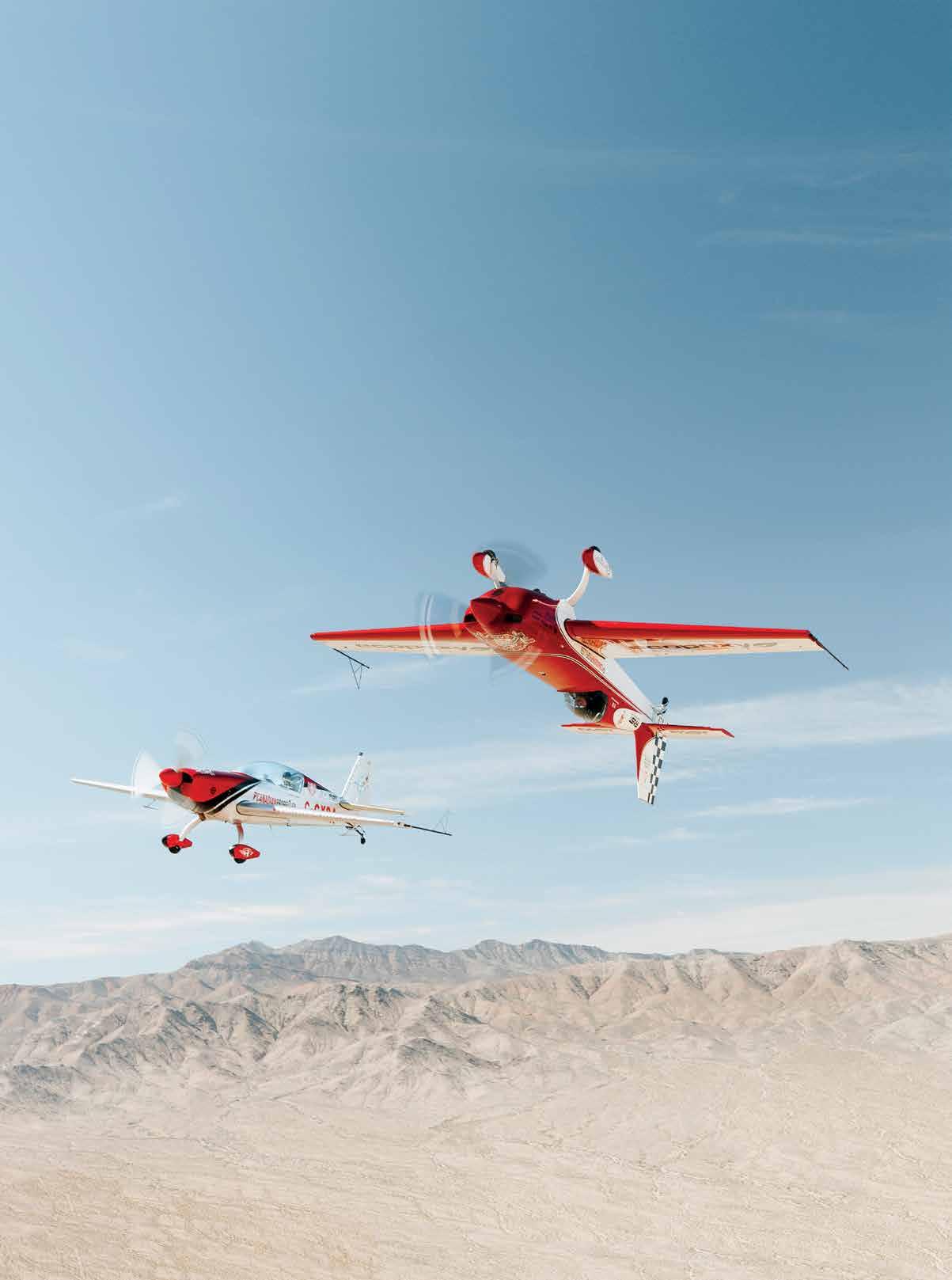
TEAM CANADA AT THE WORLD
ADVANCED AEROBATIC CHAMPIONSHIP
SPENCER DAVIS 32 CANADIAN AVIATOR MAR/APR 2024
took a deep breath of the crisp morning air on a clear day in October of this past fall. Behind me was an entire year of countless hours of preparation and training with eight other exceptional pilots. Ahead of me and my teammate, Jesse Mack, was an over 2,400-nm return cross-country flight composed of two Extras, flying in formation, that would take us through early winter conditions in Canada to the deserts of Arizona and Nevada, one of the most memorable cross-country experiences in my 20 years of flying. We would be crossing over the Grand Canyon, Monument Valley and the mountains of Utah. Sandwiched in the middle of this experience was the World Advanced Aerobatic Championship in Jean, Nevada. I was ready. Team Canada was ready. Go time.
If you are familiar with my columns, you might have a pretty good idea of what I’ve been up to, aerobatic-wise, for the past year. If not, here’s a quick refresher to get you up to speed.
In September 2022, Aerobatics Canada held two separate team qualification events, one in Rocky Mountain House, Alberta, and another in Huronia, Ontario. About a dozen pilots competed for eight spots on the team and, after the
final wing-wag (the way a pilot signals the start or finish of their sequence) was completed, I was humbled to find myself finishing in the top spot, which earned me a position as team captain. During the long winter months, we kept ourselves busy. The team selected our coach and team manager, Aaron McCartan of Iowa, U.S., who helped us put together a training plan for 2023. We prepared to compete against the best aerobatic pilots in the world, flying at the Advanced level.
One obstacle our team encountered was the vast distances separating our members, which made coordinating training camps challenging. Ultimately, we held camps in Cutbank, Montana; Ephrata, Washington; Steinbach, Manitoba; and Rocky Mountain House, Alberta. Each camp was an intensive five-day session, with pilots undertaking three 15-minute flights daily. Due to logistical and geographical constraints, it was impossible for the entire team to train together; at each camp we were always short at least one pilot. It wasn’t until we gathered in Jean, Nevada, that all eight of us, along with our reserve pilot, managed to train together for an entire week. We flew twice daily in preparation for the opening ceremonies of the WAAC.
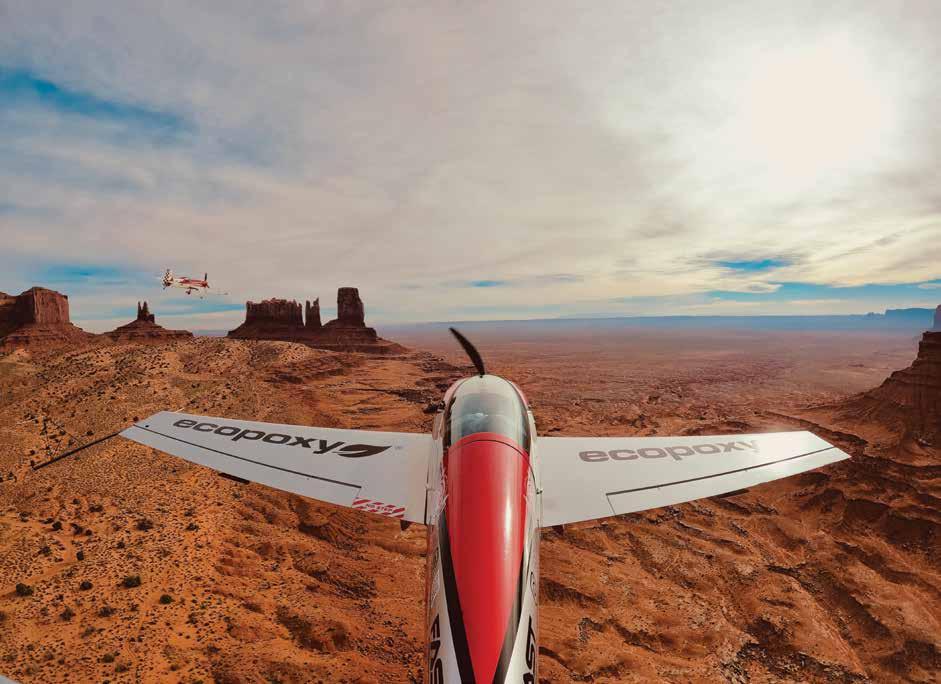
I
The author is joined by teammate Jesse Mack, exploring Utah’s Monument Valley on their return flight to Canada.
CANADIANAVIATOR.COM 33
LUKE PENNER
In mid-October our team started converging in Jean for several weeks of intense preparation, focused exclusively on preparing for the most significant aerobatic competition of our lives. Our lineup included pilots Neil Harris, Jerzy Strzyz, Ryan Chapman, Dave Barbet, Christian Baxter, Mark Cunningham and Miles Crane. Included in our team were Coach and Manager Aaron McCartan, our exceptional Assistant Manager Lenora Crane, and reserve pilot (and hors-concours competitor) Jesse Mack.
During our last week before the contest, we settled into a consistent daily schedule: Mornings began at the South Point Hotel and Casino, situated at Las Vegas’s southern tip, followed by breakfast at a Starbucks that seemed to set the record for high prices. Afterward, we would all hop into a few vehicles and make our way to a rather unusual choice of an airport for a world aerobatics championship. This airport, positioned adjacent to the soon-to-bedemolished Terrible’s Hotel and Casino and merely 10 miles north of the California-Nevada state line, became our regular haunt.
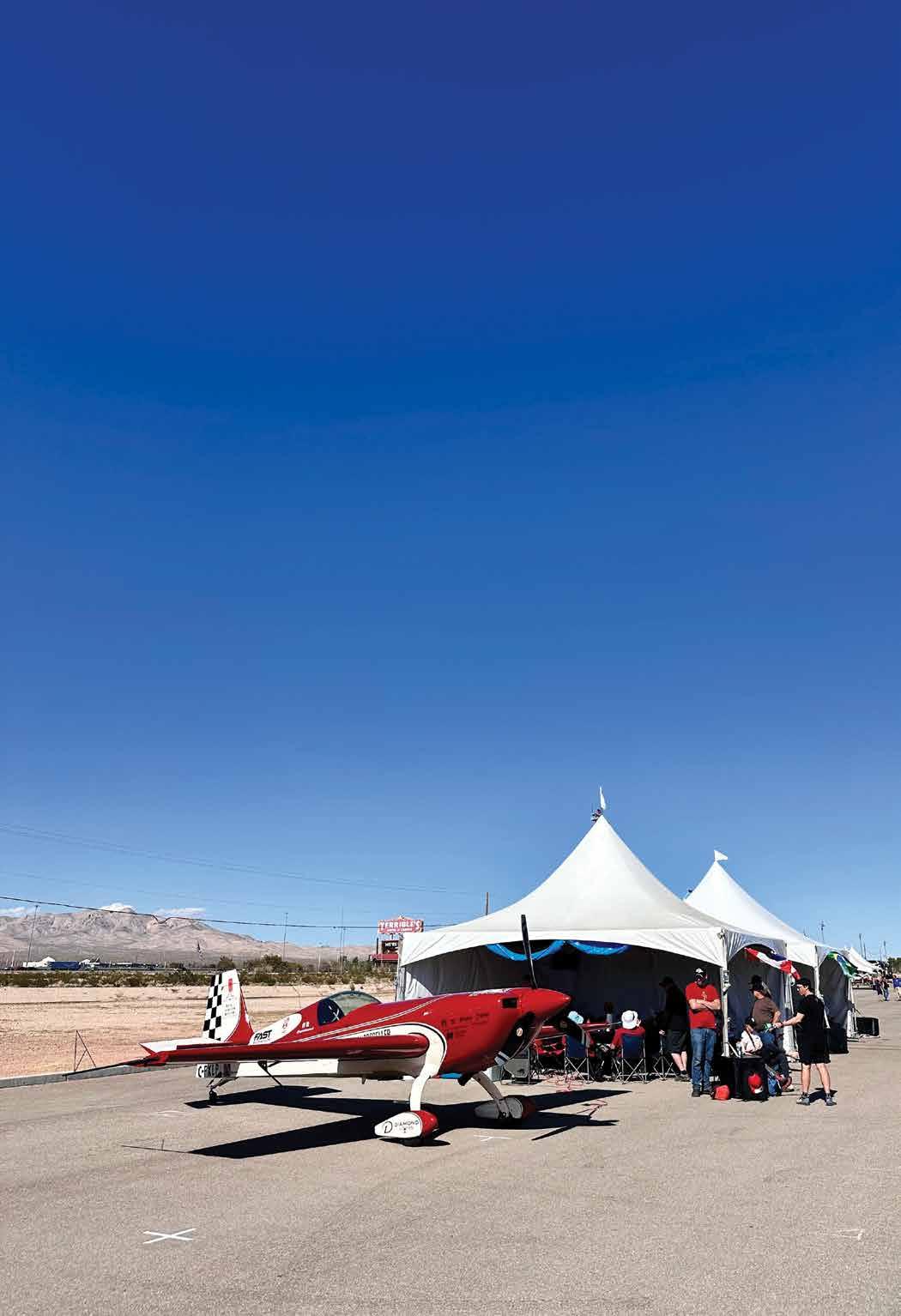
Ah, Jean Airport (0L7) is quite a story in itself. The reasons behind its selection for hosting the event remain a mystery to me. The airport was notably sparse on facilities — no hangars, no substantial shelter — yet it offered an abundance of clear, blue skies. The lack of shelter prompted our team, along with a few other teams, to rent an RV. This provided a welcome break from the relentless sun and heat, and a space for post-flight debriefings.
In some respects, the contest organizers excelled in their planning, arranging over 800 12-minute practice slots during the official practice week. These were divided between two aerobatic boxes: the official contest box located on the airport’s east side, and the area known as the proficiency box on the west side.
Apart from a trip to the iconic Las Vegas sign for a must-have team photo, our routine was fairly consistent. We found ourselves living in the peculiar microcosm of Nevada’s casino-hotels. Ours, with its gold-tinted exterior windows, had a certain gaudy, Disney quality. Inside, we navigated through clouds of cigarette smoke and rows of slot machines
The author’s Extra 330SC has its battery topped up alongside Team Canada’s tent (shared with the winning Team France).
34 CANADIAN AVIATOR MAR/APR 2024
LUKE PENNER
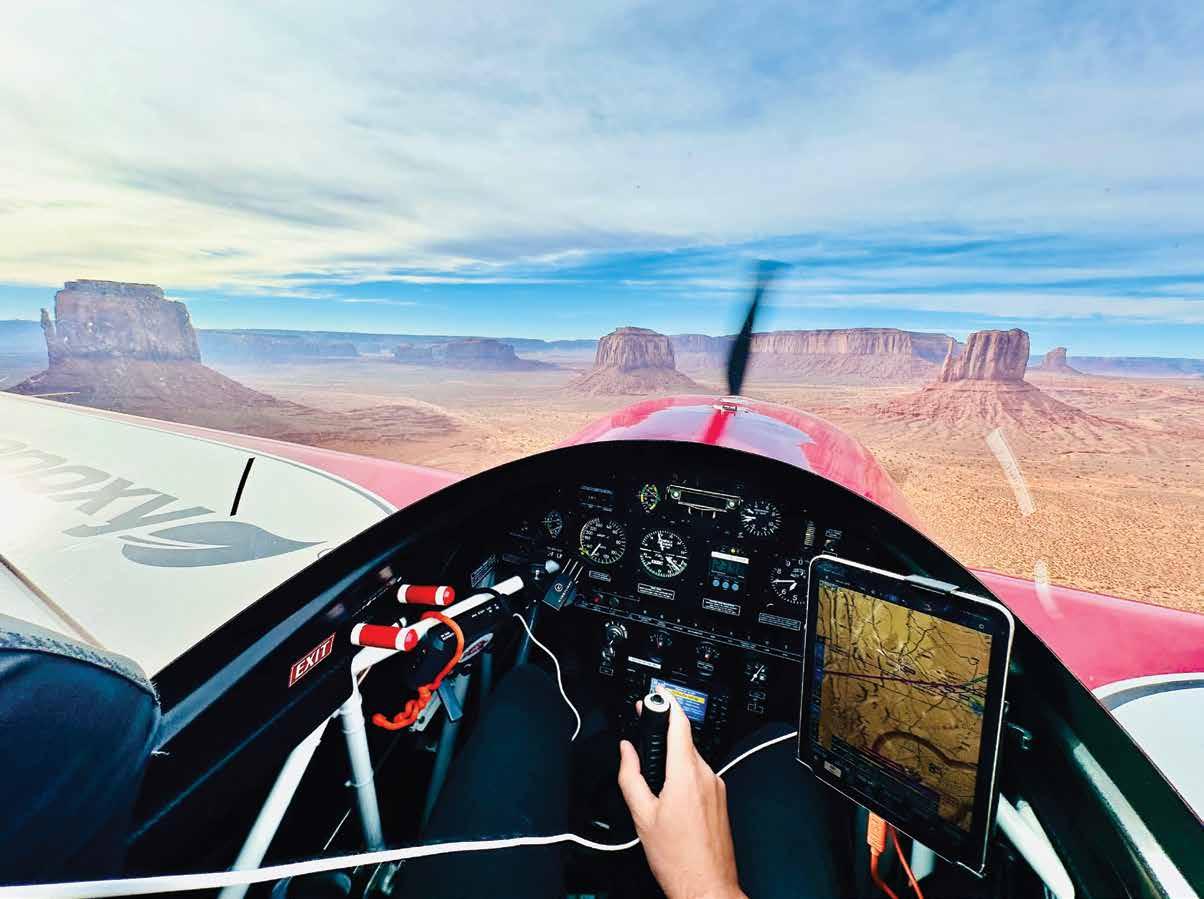

occupied by players engrossed in their games, cocktail in hand from the early morning. The ornately vaulted ceilings above us mirrored the extravagant carpets beneath our feet. The hotel offered a variety of dining options, from oyster bars to classic-styled diners. With amenities like movie theatres and a bowling alley, our team had plenty of opportunities for bonding. Then it was back to the barren sands, cloudless skies and searing heat of the desert to strategize, rev up our engines and demonstrate our skills to the world.
On a brilliantly sunny and warm day during the opening ceremonies, I had the immense privilege of being the flag bearer for our team in the parade of nations. This parade showcased pilots from over 14 countries. Walking alongside such a dedicated and hard-working group, all of whom had devoted substantial time, effort and financial resources to represent their countries at a global level in aerobatic competition, filled me with pride. The entire season demanded a monumental effort from every team member, including coaching and management staff. As the captain of this exceptional group of aviators, I couldn’t have been prouder.
Top: The author depends on his iPad and ForeFlight for navigational accuracy. | Bottom: Team photo (left to right) Miles Crane, Dave Barbet, Luke Penner, Ryan Chapman, Jerzy Strzyz, Christian Baxter, Mark Cunningham and Neil Harris.
CANADIANAVIATOR.COM 35
LUKE PENNER ALLISON PELLETIER
In the process of deciding the flying order for the nearly 60 pilots, each of us or, alternatively, our team manager, took turns drawing numbered poker chips during daily briefings over the next 10 days. For the first program, the Free-known, I ended up drawing pilot number 36, giving me a day and a half for preparation.
A distinctive aspect of CIVA world competitions is that only one pilot flies at a time, unlike at events like the IAC U.S. Nationals, where one or two holding areas are used to keep another pilot ready to enter the box immediately after the preceding pilot finishes. This makes the CIVA format more straightforward with a maximum of 30 pilots flying each day.
A significant advantage of this slower pace is the ample time it allows for mental preparation, which proved beneficial as we progressed through the four grueling programs of the championship.
The event presented us with the rare chance to interact with outstanding aerobatic pilots
from across the globe. We were delighted to share our tent with formidable Team France. The Romanian pilots were fantastic, and Team Brazil was composed of many lovely people who I hope to visit one day. One of the warmup pilots, Martijn Kersten of the Netherlands, was a beacon of positivity, generously volunteering for the event and keeping us cheerful with his humour. I must say, our tent was the place to be.
Each day brought new supporters to our modest headquarters, with its tent walls fluttering in the wind, including friends and family from Canada, Australia and the U.S. They breezed in between passing tumbleweed and their visits were a joyful boost for us. The moment we made our way to our planes, our supporters would quickly pile into rented cars and speed off, kicking up a cloud of sand, to reach a spot near the judging line in time. This location offered them the best view to watch our flight sequences.
 SPENCER DAVIS
SPENCER DAVIS
36 CANADIAN AVIATOR MAR/APR 2024
Jesse Mack ferries Extra 300L C-GXRA past Colorado’s Sangre de Cristo Mountains enroute to Santa Fe, New Mexico.

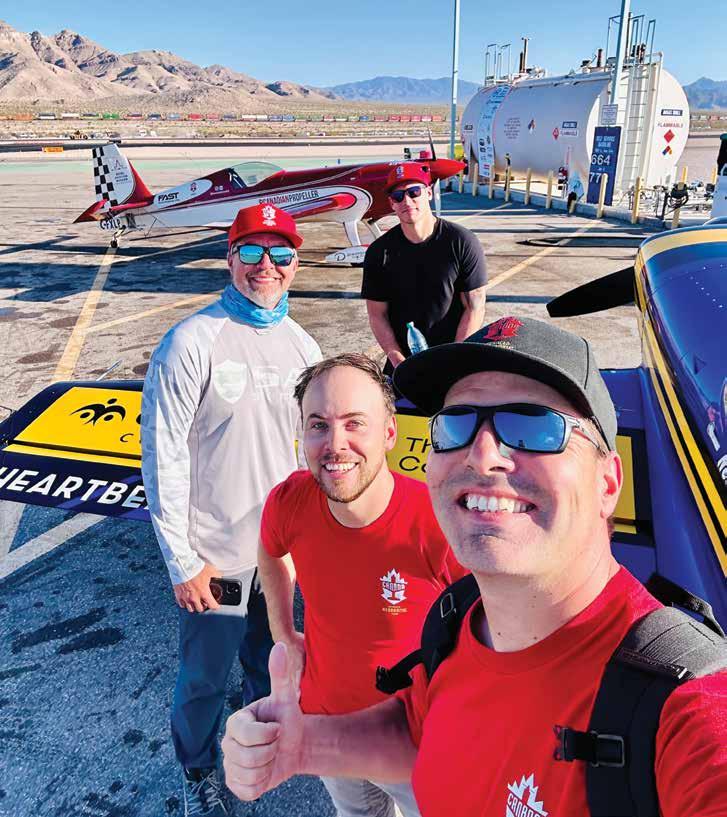
aerobatic Glossary & Terminology
WAAC
World Advanced Aerobatic Championship
FAI
Fédération Aéronautique
Internationale (translated to World Air Sports Federation). It is the international sport aviation’s governing body.
CIVA
Commission Internationale de Voltige Aerienne (translated to FAI Aerobatics Commission). It is the sub-organization governing international aerobatic competition.
Intermediate level –international competition
For pilots of moderate aerobatic experience. Competitions at categories below this are at national or local club levels.
Advanced level – international competition
This is for more experienced aerobatic competitors.
Unlimited level – international competition
For the best pilots in the world.
Free Known Sequence
CIVA publishes five compulsory figures at the start of each year. A pilot then adds five of their own figures to put together a “Free known.”
Free Unknown Sequence
The pilot will not have seen the sequence before, it being composed at the event from figures submitted by teams or individual pilots and flown for the first time in front of the judges.
PHOTOS: LUKE PENNER
CANADIANAVIATOR.COM 37
Top: Harv’s Air’s husband-and-wife AME crew Matthew and Tara Granson working on Christian Baxter’s Extra 330SC before the WAAC kicked off. | Bottom: Team Canada pilots Luke Penner, Neil Harris, Ryan Chapman and (on the left) coach Aaron McCartan are exhilarated after their first competitive flight at the 2023 WAAC.

Coach Aaron and other team members would graciously and vividly explain each ‘aerial dance’ to our fans. Some of them were new to the sport but rapidly became enthusiastic followers. Upon lining up for final approach, I would catch a glimpse of the growing sea of the red shirts our fans wore, which warmed my heart.
So, how did it all unfold? When I heard the chief judge’s voice over the radio saying, “Pilot 36, you’re cleared into the box. Have a good flight,” most of my nerves and anxiety had dissipated. It was just me, my airplane, the aerobatic box and a meticulously planned routine to execute. Being 3,000 feet above the Nevada desert, surrounded by mountains with a massive solar thermal plant to the south and Las Vegas to the north, was both surreal and exhilarating.
For someone from a small town in southeastern Manitoba, it is astonishing to think about where aviation had taken me — this was definitely one of those moments of realization. As I dived into the box, rocked my wings three times, and sped up my Extra 330SC to 190 knots to start my sequence, I entered a kind of flow state, where every manoeuvre felt instinctive and automatic. (To get a real sense of what it’s like to be in an Extra moving at 320 feet per second, check out my YouTube channel, Luke Penner Aerobatics.) I experienced +9/-7G while flying the most complex sequences I had ever flown in competition.
Just five minutes later, as I rocked my wings three times to indicate the end of my sequence, I felt a rush of elation. Despite the immense pressure of competing at a world-class level,
38 CANADIAN AVIATOR MAR/APR 2024
Extra 330SC (foreground) and Extra 300L, both owned by Harv’s Air, flying over the Ivanpah solar thermal plant near Jean, Nevada. SPENCER DAVIS

“Being 3,000 feet above the Nevada desert, surrounded by mountains with a massive solar thermal plant to the south and Las Vegas to the north, was both surreal and exhilarating.”
I had managed to successfully carry out the strategy devised by me and my coach. Throughout the event, I executed four ‘clean’ flight programs without any zeros.
However, I encountered some unfortunate luck during the third program, Free Unknown 2. In the final figure, four of the eight judges marked me with a low call, believing I had flown below the 200-metre floor of the box. Despite having onboard video evidence to the contrary, I couldn’t contest the low call and ended up with a 200-point penalty, which pushed me down from the top 10 to a 20th -place finish. Team Canada secured the fourth position, trailing behind the U.S., Romania and France, who deservedly took home both the team and individual trophies.
Participating in the WAAC was an incredible experience, but what made it
truly extraordinary was the presence of so many friends and loved ones who travelled to Las Vegas to support me and the team. Their unwavering encouragement has been crucial in my journey, and it means the world to me. I’m also deeply thankful to my sponsors for their backing this year, helping me chase my dream and perform at my best. The 2023 WAAC marks the end of my time competing in the Advanced category.
A heartfelt thanks to all of you, readers, who have followed my journey and that of Team Canada to the WAAC. We created history by being Canada’s first fully fielded team at a world aerobatic event. Next year, I’m excited to step up to the highest tier in competition aerobatics: Unlimited. Continue following my column Unusual Attitudes for updates on my most challenging adventure yet.
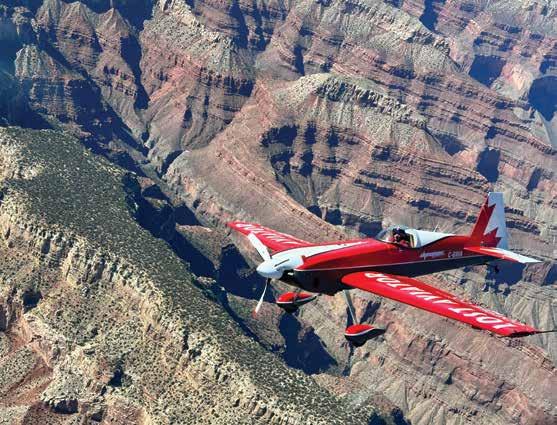

SPENCER
LUKE PENNER CANADIANAVIATOR.COM 39
Left: Ryan Chapman flying his Staudacher S300 over the Dragon Pass in the Grand Canyon while in formation with Luke Penner and Jesse Mack, enroute to Jean, Nevada. | Right: Team coach Aaron McCartan with commemorative plaque present to him by Team Canada.
DAVIS
A Once-in-a-Lifetime Experience NORTH to
ALASKA
 BY CURTIS PENNER | PHOTOS BY RICK HIEBERT
BY CURTIS PENNER | PHOTOS BY RICK HIEBERT
40 CANADIAN AVIATOR MAR/APR 2024
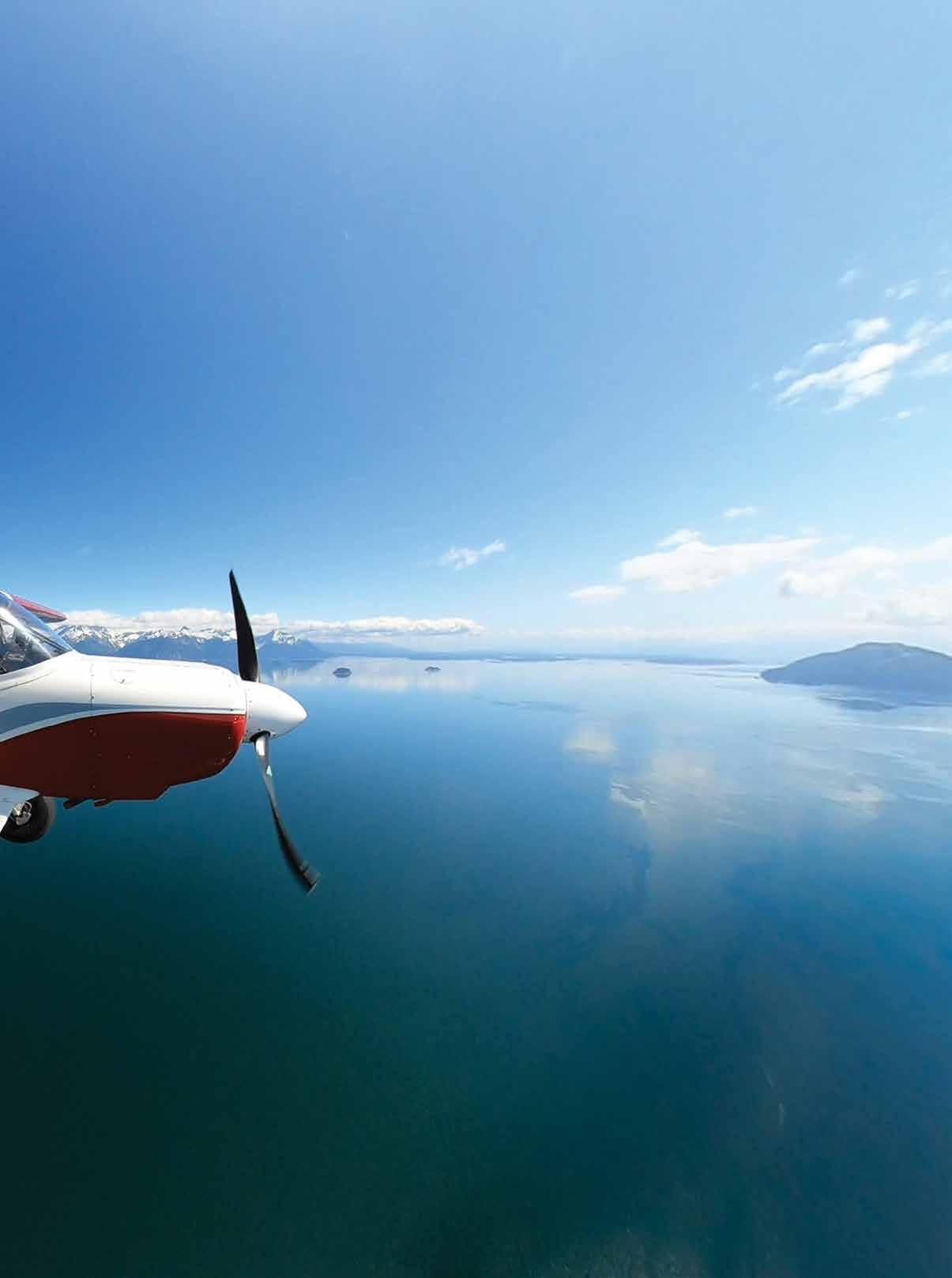
The ‘mountain range’ in my office had formed over many years. Peaks named Maps, Books, Articles, Websites and Contacts covered the counter. A thousand hours of tailwheel time and backcountry mountain trips to Arizona, Colorado, Virginia, Montana, New Mexico, Utah and Idaho were in my logbook. The final piece of the puzzle dropped into place when a friend indicated he also was on board with his airplane. Now it was time to tackle Alaska — the ultimate challenge.
The initial planning priority was confirming objectives for the trip, and attitudes toward risks were similar. That established, goals included beach and gravel bar landings, flying over glaciers, icebergs and cruise ships, seeing gold mining history, flying the Denali, camping beside the planes and seeing the wildlife. After adding things like Watson Lake’s Signpost Forest, Kennecott Copper Mine and historic places like Dawson City, the itinerary lengthened very quickly.
A two-week travel window combined with four travel days cover the 1,500 miles each way to Watson Lake in the Yukon, leaving only 10 days for Alaska. The universal opinion of others who had done the trip was, “You will need perfect weather for the entire time, and that’s unlikely.” Quoting Jimmy Doolittle, “I could never be so lucky again.”
We got it all done in under two weeks in June. Let me tell you how.
Obviously, routing was critical. Anyone considering going to Alaska knows there are four primary route options. I’ll list them from west to east and outline our choices and reasoning.
1. The Coast
This was a non-starter. Despite the potential for what others have described as absolutely stunning views, the absence of emergency landing options for wheeled aircraft made it too risky, especially considering the high likelihood of poor weather.
2. The Stewart-Cassiar Highway
This was Plan A. It would provide access to southeast Alaska’s coast to see and experience the iconic geography that motivated our trip. There are places to land if required and fuel range is not an issue, but it requires good weather.
3. The Trench Plan B was for the northbound trip. It has the advantage of relatively easy geography and straight-line travel with available emergency landing options.
4. The Alaska Highway
This was the last resort for northbound travel, and we planned to use it only if weather further west was unsuitable. We thought the other routes offered better scenery and a more interesting experience. However, it is the lowest, flattest, easiest and (usually) safest route.
CANADIANAVIATOR.COM 41
Flying over the vibrant blue waters of Glacier Bay, west of Juneau.

Essentially, the building crescendo of dramatic and spectacular scenery to the west has to be balanced against increasing risks approaching the coast.
Once up north, we planned to do an inverted ‘U’ route, with the three sides being up Southeast Alaska’s coast, across to Denali, then down to Dawson City and Watson Lake. We hoped to do the Alaska coast first, as the weather there is more uncertain, then work our way towards easier weather and routes as we went east and then south. If forced to, we would reverse the circuit.
As we all know, last summer’s wildfires were the proverbial ‘black swan’ event. Edson, Alberta, the first route decision point where we would either turn north to follow the Alaska Highway or continue west towards either the Trench or the Cassiar route, was under an evacuation order. The south wind pushing the smoke north made the decision for us. The Alaska Highway was IMC, so we followed the Yellowhead Highway west in rapidly improving visibility, enjoying stunning views of the Rockies around Jasper, and then carried on to Prince George, where the determination between taking the Trench north towards Watson Lake or west until the Stewart-Cassiar highway took us north for our Plan A routing had to be made.
Weather looked promising so we chose the Cassiar route, filed our eAPIS report for Juneau (required for entry into the U.S.), and followed that amazing route up to Telegraph Creek where we set up the tents. Next morning, we followed the VFR route to Juneau and cleared border formalities there.

42 CANADIAN AVIATOR MAR/APR 2024

“The old maxim about flying to Alaska ‘sometimes invited, sometimes tolerated and sometimes told to go home’ was answered with ‘you are invited’ by both government and Mother Nature.”
One note applicable here; there is a time zone change at the Alaska border, so we arrived at Juneau an hour early. Fortunately, the CBP officer had been watching our flight on FlightAware and showed up early to meet us. Thanks to this efficient and courteous officer, a few minutes later our Alaska exploration commenced. The old maxim about flying to Alaska “sometimes invited, sometimes tolerated and sometimes told to go home” was answered with “you are invited” by both government and Mother Nature.
One of the myriad preparations for the trip had been the purchase of Uncharted Airstrips (2142), Glacier Landing Sites (117) and VFR Routes (68) ForeFlight layers. This made the trip exponentially safer and opened up numerous options for places to explore. The VFR route portion had already proven invaluable during our passage through Alberta and British Columbia, and their utility was immediately obvious when we left Juneau. We followed one up Lynn Canal, over and down Casement Glacier, continued to Lituya Bay where we did a beach landing. Two and a half hours of the most spectacular flying I have ever experienced went into the logbook. It is only when you are flying above it that you realize how incredible Alaska really is.
 In the vicinity of Mt. McKinley in Denali National Park.
In the vicinity of Mt. McKinley in Denali National Park.
CANADIANAVIATOR.COM 43
Pristine white landscapes west of Haines, Alaska greet adventurous pilots.
Continuing up the coast, we saw our first bears near the Alsek and Tanis cabins in the Tongass National Forest before we stopped for the night at Italio River. The electric fence around the airplanes certainly allowed us a better night’s sleep. I would like to offer our thanks to the visionary behind the gem that is the Tongass National Forest fly-in cabins.
The Wrangell-St. Elias National Park is arguably the crown jewel of Alaska’s treasures that are best experienced by air. I’m sure the cruise ship passengers we overflew in Yakutat Bay were “ooh-ing and aah-ing” about their view of the face of the Hubbard Glacier a mile or so away, but we flew next to it and then continued up the glacier, marvelling at the huge crevasses and deep blue pools. A few miles later, Icy Bay was another surreal experience. The beauty unfolded in layers, each one more enchanting than the last. This part of Alaska truly cannot be described – it must be seen, so we had the cameras rolling so we could share the experience with others.
Following another VFR route inland over the Tana Glacier, we were able to do some gravel bar landings on the Tana River before continuing on to visit the Jake’s Bar National Park Service cabin before stopping at May Creek for the night. Seeing the size of the bear prints on the sand made the decision about putting up the electric fence.
The operations hub in this area, McCarthy is much more than a fuel stop. The Kennecott mine tour is excellent, and the rustic ambience of the town extends to the vehicles on the streets and old rooming house hotel. (It was time for a shower after four days.)


“The beauty unfolded in layers, each one more enchanting than the last.”
44 CANADIAN AVIATOR MAR/APR 2024

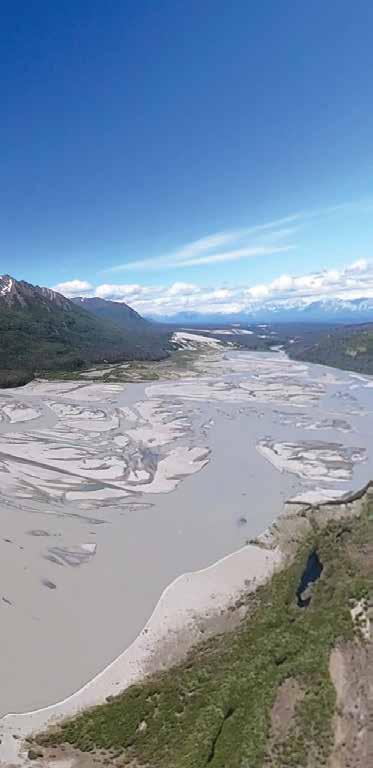
Next night was at Peavine Bar after having followed a VFR route over the Russell Glacier, Chisana, the Cooper Pass, down the Nabesna and Regal Glacier with a landing on the Amphitheatre Creek strip next to the stunning glacial lake at the foot of the Nizina Glacier. Once again, the views defied description. The following morning, we headed for Talkeetna, the base for Denali experiences and all the associated tourist trappings. After another stay at a place with a shower, we awoke to what is a rare event around the mountain – clear skies. We launched early to beat the tour operators and were able to complete a 1.5-hour, 186-mile circumnavigation of one of creation’s most spectacular monuments. Our feelings were perfectly expressed by American novelist Stephen Coonts: “I am but a gnat flying by the face of God.” Three hours later, we were immersed in the frontier atmosphere of Dawson City, Yukon. A once-in-a-lifetime experience that included the Sourtoe Cocktail, Gold Tooth Gerties, panning for gold and checking out the Dredge No. 4 National Historic Site occupied our time there.
The next day we were in Watson Lake’s signpost forest, a fitting reminder of other adventurers from all over the globe captivated by the idea of going to the Yukon and beyond to Alaska. Among the thousands of signs, we even found ones from our hometowns.
Forest fires and smoke were still there but winds were now from the north, so we could overfly hundreds of fires but still be in VFR conditions if we took a direct southeasterly route back home. Continuing the pattern for our entire trip, weather ahead was good while weather closed in behind us. We headed back home with an indelible impression that will stay with us forever.
CANADIANAVIATOR.COM 45
Above: Overnighting at the Italio River Forest Service cabin in the Tongass National Forest on the shores of Alaska. Left: The waters of Tana River meander along endless channels, typical of an Alaskan braided river.
HAVILLAND’S
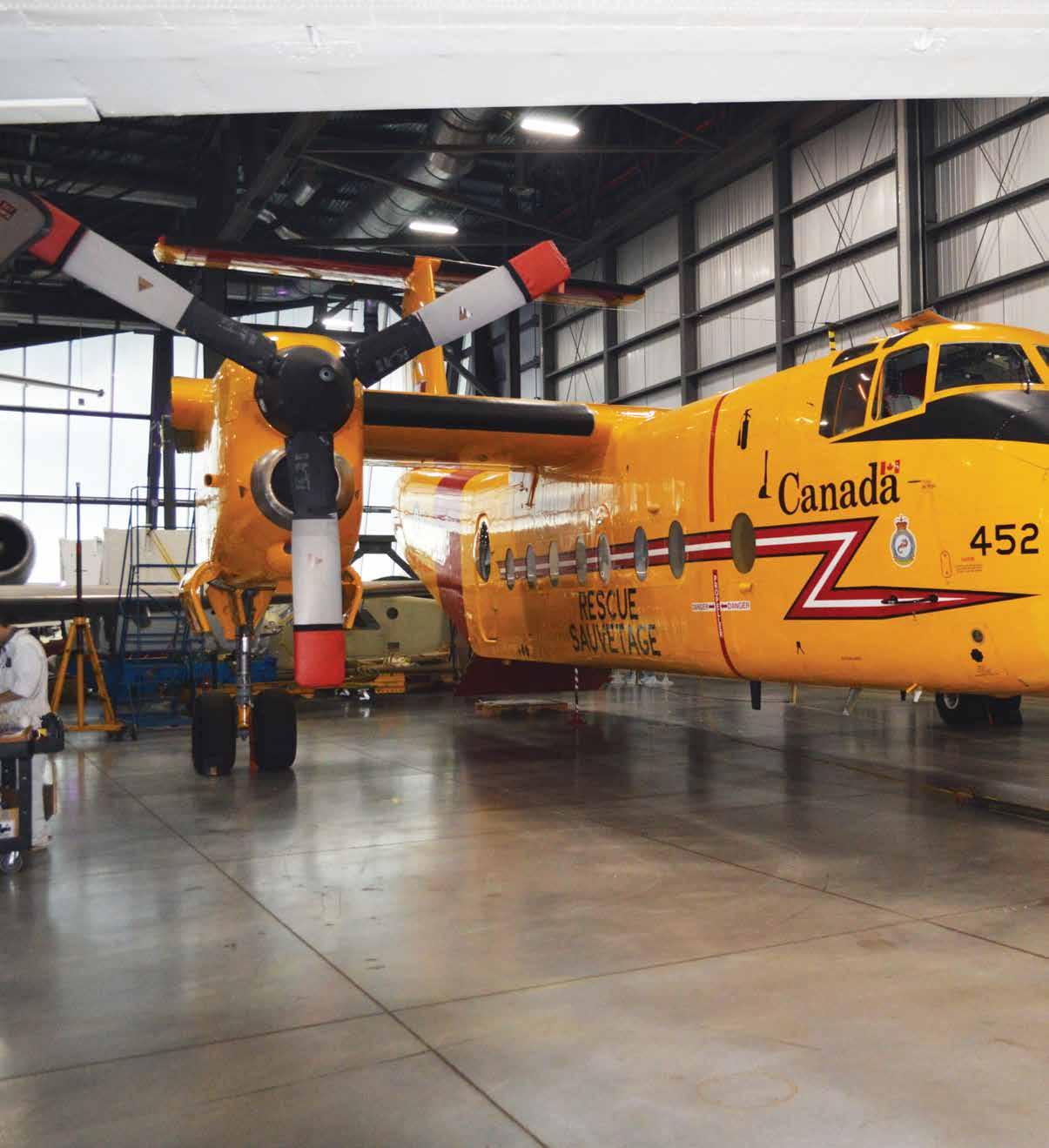 BY ROBERT S. GRANT
BY ROBERT S. GRANT
A Canadian Legend Takes Rightful Place At CASM 46 CANADIAN AVIATOR MAR/APR 2024
DE
VENERABLE BUFFALO
 ROBERT S. GRANT
ROBERT S. GRANT
As my shoes slammed into the snowbank, I reminded myself that a close look at the Canada Aviation and Space Museum’s (CASM) latest de Havilland acquisition rated higher than a shivering scalp. Media relations officer Philippe Tremblay extended an invitation to Canadian Aviator magazine for the official welcome of RCAF Buffalo CC-115 Tail Number 452 to Rockcliffe’s pristine premises. Now, after stumbling through a 15-knot gale, I staggered into the museum’s airplane-packed Reserve Hangar.
The brilliant yellow aircraft came across as breathtaking in brilliance and size. Museum director-general Christopher Kitzan explained that hangarage space dictated a temporary wingless exhibit. On October 11, 2023, six flatbed transport trucks had delivered the prize from CFB Trenton where the sleek example of aerial ingenuity underwent assembly by RCAF veteran technicians and CASM’s Réjean Demers and team.
The existence of 452 and another 125 from Downsview’s assembly lines dated from the 14-cylinder Pratt & Whitney R-2000-powered DHC-4 Caribou. Efficient and record setting for its era, de Havilland acceded to US Army requests to tender a more powerful and larger successor. Management embarked on a turbine transport project capable of hauling almost double the load.
Equipped with 2,825-shp General Electric CT64-820-1 turboprops, the prototype Buffalo flew on April 9, 1964, as the DHC-5A and the RCAF ordered 15, designated as CC-115s by December 1967. Price per unit, as explained in Fred Hotson’s The De Haviland Canada Story, averaged $1,550,000. The museum’s July 8, 1967, example initially carried civil registration CF-QVA with serial number 06 before becoming 452 with Saint-Hubert-based 429 Squadron. Unlike most military acquisitions, 452 reverted to the same lettering in 1972 on lease to de Havilland for icing trials before returning to military markings. As a cargo carrier, 12,500 pounds could be taken aloft — more than twice the load of a Douglas DC-3.
With outstanding STOL capabilities, thanks to labyrinths of full span double-slotted flaps and spoilers, 452 could carry 41 troops, so said a De Havilland News Backgrounder. With full fuel, range reached as much as 1,391
CANADIANAVIATOR.COM 47
miles. Buffalo 452’s flight planning sheet indicated a 45,000-pound maximum takeoff weight and a 29,600-pound empty weight, with other figures indicating 42,000-pound departures and 100 knots landing speed. A 27-foot, 10-inch wheelbase allowed tight turnarounds on narrow airstrips. In 1974 I had witnessed such a practical feature at Cape Dorset (Kinngait), 244 miles west of present-day Iqaluit, from Twin Otter CF-YFT. Another aviation writer, Donald R. MacNeil, remembered a landing in 2005 at Rockcliffe’s 3,300-foot x 100-foot asphalt surface:
“…coming in from the east, he was fully stopped by the time they were a third of the way down the runway. They then proceeded to back up through the run-up area and make another backing left turn onto the parking apron.”
“FORTUNATELY, CASM’S FAR-SEEKING HISTORIANS AND CURATORS DECIDED A DHC-5 SHOULD JOIN THE ROCKCLIFFE COLLECTION.”
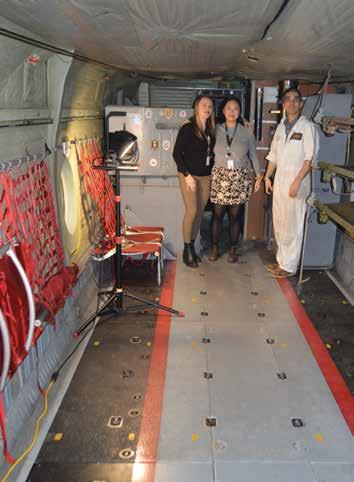
Buffalo 452 and its 96-foot wings carried Canada’s colours in cold countries and tropical ones. From 1973 until 1979, 116 Air Transport Squadron flew peacekeeping missions for United Nations in Egypt and Somalia. Another mission, known as Operation Oxide, took place over Rhodesia’s mamba-infested jungles supporting election observers with 424 Transport Squadron. Despite their noble efforts, the regime became Zimbabwe under dictator Robert Mugabe on April 18, 1980.
After Middle East duties, 452 returned to Canada for its remaining service, mainly at CFB Comox in British Columbia. Besides public fly days, airshows and open houses, the T-tailed aircraft became an important component in Canadian Armed Forces Search and Rescue (SAR) exercises on both sides of the country. Eventually, age brought on obsolescence and skyrocketing maintenance, leaving little choice except to stand down the type. The final halfdozen-based at Comox parked permanently on January 15, 2022, even though, said aviation aficionado Jerry Vernon, the Comox crowd acquired several
disassembled Buffalos for parts and training.
Fortunately, CASM’s far-seeking historians and curators decided a DHC-5 should join the Rockcliffe collection. Buffalo 452’s final operational trip occurred January 15, 2022, and negotiations resulted in a parade of six flatbed trucks months later. The spotless machine became a member of CASM’s de Havilland group, including a trio of ‘Number Ones’ (i.e., Beaver, Twin Otter and Dash 7), as well as a higher serial-numbered single Otter and Chipmunk.
In my case, finger, toes and scalp quickly warmed and curator Erin Gregory and RCAF personnel provided a walkaround inside the Buffalo, which truly seemed fresh out of Michelangelo’s studio. Rarely had I been in close proximity to such a mechanical masterpiece and its rear cargo ramp, but long ago noticed a trio of abandoned Buffaloes in the grass by the Cameroon Air Force beside the cities of Douala and Yaoundé. Forlorn from a distance, approaching them could have brought on a holiday in an African jail. Buffalo 452’s 31-foot, five-inch and eight-foot, nine-inch cabin compartment showed not a handprint nor dust bunny. Even documents and paperwork aligned on a table by Demers waited in perfectly straight rows. Within the SAR-configured 1,580-cubic-foot volume, crew amenities had not been overlooked. A hot plate on the right eased multi-hour searches for downed aircraft and a can opener stood ready. A stainless-steel coffee pot reflected my hairline.
The cockpit resembled a Twin Otter’s limited confines, with power levers almost identical in size. Beneath the instrument panel, D.H. stamped on rudder pedals left no doubt as to who manufactured 126 of all versions. Yellow paint stripes bordering the fire extinguishing system seemed familiar, and ribbed plastic grips on the control
ROBERT S. GRANT
Canada Aviation and Space Museum curator Erin Gregory (L) and Assistant Curator Valerie Wood team with restoration expert Réjean Demers to demonstrate 452’s functional interior.
48 CANADIAN AVIATOR MAR/APR 2024
wheel undoubtedly remembered the touches of many pilots. Behind the front seats, navigational charts and approach plates sided a navigator’s station. Topographical maps on a desk suggested the teams who formerly lived here understood tree-top navigation. Curiously, the RCAF left behind what looked like new out-of-the-box headsets.
Few aviation enthusiasts know of the lengths undertaken by RCAF test pilots to ensure unpressurized Buffalos could handle the heavy demands of STOL activities. Former Lt. Col. John Lawson recalled cold weather testing at Churchill, Manitoba from January 25 until March 1, 1968, in -45°C air. All systems functioned. An early morning trial on May 11, 1968, at RCAF Station Uplands (Ottawa) unintentionally demonstrated the range of extremes
Buffalo 452 and sister ships could endure.
severed stringers and supports and placed temporary I-beams without reskinning. They straightened wrinkles to enable Lawson and Herbert to ferry 452 to Downsview for further repair. On arrival, de Havilland personnel marvelled at the aircraft’s proboscis wrapped with brilliant yellow bandages. Nevertheless, 452 departed the factory in like-new condition.

Purposely configured with maximum rear centre of gravity and minimum fuel to evaluate maximum STOL capabilities, Majors George Herbert and Lawson firmly planted the aircraft onto the asphalt with full flap, applied full reverse and maximum braking to stop within the fuselage length with assistance from automatic wing spoilers. Suddenly, the nose “majestically rose up in the air” as pilots snapped power levers forward and the nose slammed down into the runaway almost hard enough to push potholes into the manicured surface.
“Bam! A lot of confusion. Nothing caught fire but we had structural damage and bent the nose up and the leading edge of the wing across the top of the cabin wrinkled both sides,” said Lawson. “Engines were canted about two degrees down. All this happened when we were theoretically dead-stopped with all six tires on the runway. Quite an event! Later, we learned that the aft C of G and sloshing fuel may have provided the impetus for the sudden surprise.”
One pilot admitted that many RCAF aircrew did not hold the aircraft in high regard due to a poor reputation for serviceability. A compact powerplant with a 720-pound dry weight, the 2,825 shp meant a high power-toweight ratio for a turbine engine of the era. Pilots sometimes noticed twitchiness upon application of takeoff settings. Anyone filing flight plans direct from Station Trenton to Winnipeg could often anticipate maintenance delays at Thunder Bay.
After 24,112.6 flying hours, 452 can expect tender care in CASM’s Reserve Hangar. One veteran on type pointed out that the logbook’s 22,931 landings took place under STOL conditions and doubly proved the airframe. Originally equipped with ‘steam gauges’, the RCAF upgraded to a glass cockpit and installed an autopilot. Considered for emergency response and general response purposes, the Canadian-designed Buffalo carried Canada’s flag throughout the globe.
“AFTER 24,112.6 FLYING HOURS, 452 CAN EXPECT TENDER CARE IN CASM’S RESERVE HANGAR.”
“The Buffalo was a great airplane and there was no better time for it. There are some things aircraft do very well and are built to do certain things,” said former 424 Squadron and 116 Air Transport Unit Squadron Col. Dave Lowdon, who occasionally found himself in 452 before his 31-year RCAF career ended in 1996. “It was built to do short landings and short takeoffs and when you did that, you just knew everything was right and seemed like it was on rails and you had confidence in a Buffalo.”
With the aircraft moved to Ottawa’s Hangar Ten, mechanics placed a jack under the front section,
A peek outside the Reserve Hangar’s door indicated I might not survive the journey from 452’s glow to my cold-soaked Volkswagen.
Buffalo 452 in camouflage colours had an intimate encounter with the runway at Ottawa’s Uplands airport many years ago. It wasn’t until later that it was repainted in Search and Rescue yellow.
CANADIANAVIATOR.COM 49
The Your Source for Canadian Aviation Literature

THE LIFE OF A PILOT
Bush Planes and Water Bombers
These are the adventures of retired pilot Glen Goobie, who flew countless missions in Newfoundland and Labrador and across Canada and the U.S. He completed his flying training in Moncton, New Brunswick, and his early flying career took him to Northern Ontario for a couple of years. Upon returning to Newfoundland, Goobie flew with Newfoundland Air Transport, Gander Aviation, and the provincial government’s water bombers until his retirement after 40 years as a pilot.
AUTHOR: Glen G. Goobie
PRICE: $26.95 (includes shipping)
NEW WARPLANES TO ALASKA

This hardcover book is a tribute to the hundreds of men and women who toiled in the harshest of climates to help decide the outcome of WWII. The author interviewed of Canadian, Russian and American veterans and acquired hundreds of photos to fully recount this amazing part of history. Details of the Russian portion of the airway and their military operations, long hidden by an impenetrable veil of official secrecy, are revealed here for the first time. This book will engage anyone interested in WWII, aviation or Northern history.
AUTHORS: Blake W. Smith
PRICE: $53.95 (includes shipping)
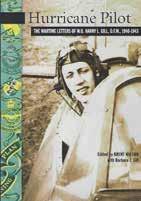
HURRICANE PILOT
Harry Gill, of Fredericton, N.B., enlisted in the RCAF in 1940 at the age of 18. During his short but adventure-filled career, he flew a Hurricane fighter bomber over France, England and India and was awarded the Distinguished Flying Medal. He died in 1943 when his airplane was shot down over Burma (Myanmar). These are the letters to his parents and siblings.
EDITED BY: Brent Wilson
PRICE: $23.95 (includes shipping)
NEW

CAMOUFLAGED KILLER
RCAF Colonel Russell Williams commanded the largest Canadian Forces base in the country. He had personally piloted prime ministers and members of the Royal Family, and was one of the most respected and trusted soldiers in the military. He was also a rapist and a murderer. This is the disturbing true account of how one of Canada’s highestranking military officers became one of Canada’s most notorious criminals, including his ultimate capture, trial and conviction.
AUTHOR: David A. Gibb
PRICE: $24.95 (includes shipping in Canada)

ALASKA’S FATHER GOOSE
Nicknamed Father Goose because of his many thousands of hours piloting the Grumman JRF Goose, Captain Gerald A. Bud Bodding’s career began in the age of the Curtiss Jenny and lasted through Alaska Airlines’ jets. Graduating as a commercial pilot in 1939, Bodding began a remarkable aviation career as a junior pilot with three of Alaska’s flying legends: Shell Simmons, Bob Reeve and Bob Ellis. Bodding’s logbooks read like a roster of the great planes from aviation’s Golden Age.
EDITED BY: G.P.LIEFER
PRICE: $26.95 (includes shipping)

NEVER A DULL MOMENT
As we enter the peak of the fire season in North America, one would think that books about aerial attack on forest fires would be cluttering bookshop shelves. Though literature on this subject is surprisingly sparse, Plawski’s book contains numerous revealing and exciting first-hand accounts of the formative years of this business. In colourful language always spiked with humour, the author describes the first dozen of his 35 years of firebombing in Canada and California.
AUTHOR: George Plawski
PRICE: $44.95 (includes shipping in Canada)

THE DEFENDERS
On June 2, 1942, when Japan launched an attack on US Navy facilities at Dutch Harbor, Alaska, the United States officially appealed for Canada’s help in the defence of the besieged Alaska and its Aleutian Islands, which were under attack and partially occupied by Japanese air and naval forces. Canada immediately sent 15 Squadrons of battle-hardened RCAF fighter and bomber reconnaissance aircraft. The Defenders tells the story of each RCAF Station or Detachment, both in Alaska and on the westernmost British Columbia coast.
AUTHOR: Christopher Weicht
PRICE: $65.00 (includes shipping)
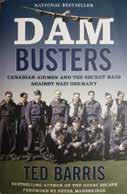
DAM BUSTERS
It was a night that changed the Second World War. The secret air raid against the hydroelectric dams of Germany’s Ruhr River took years to plan and included the best airmen RAF Bomber Command could muster—many of them Canadian. It was a military operation that became legendary. Based on interviews, personal accounts, flight logs, maps and photographs of the Canadians involved, Dam Busters recounts the dramatic story of these young Commonwealth bomber crews tasked with a high-risk mission against the enemy.
AUTHOR: Ted Barris
PRICE: $42.95 (includes shipping)
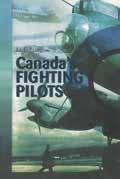
CANADA’S FIGHTING PILOTS
Cosgrove recounts the lives of Canada’s outstanding pilots and their exploits in the two world wars. From the brilliant individualists who flew in the First World War to the tough and dedicated bomber crews of the Second, this is the story of Canadian airmen and their remarkable contribution to the war effort. An essential book for any aviation and history enthusiast.
AUTHOR: Edmund Cosgrove
PRICE: $33.99 (includes shipping)
NEW 50 CANADIAN AVIATOR MAR/APR 2024
GO TO FOR MORE AVIATION BOOKS
To order, visit aviatorsbookshelf.ca or call 604-999-2411
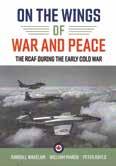
ON THE WINGS OF WAR AND PEACE
Bringing together leading researchers on Canadian air power, the book captures the history of the RCAF during the first decades of the Cold War – a period which marked the zenith of air force accomplishments in peacetime Canada. The volume covers topics that go beyond straightforward flying operations, examining policies that drove operational needs and capabilities and the personnel, technical and logistical functions that made those operations possible.
AUTHORS: Randall Wakelam, William March and Peter Rayls
PRI
CE: $59.95 (includes shipping in Canada)
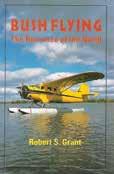
BUSH FLYING — THE ROMANCE OF THE NORTH
This book offers readers a kaleidoscope of aviation adventures survived by wilderness pilot and Canadian Aviator columnist and feature writer Robert S. Grant. Having logged more than 20,200 hours flying hours, Grant takes readers coast-to-coast and into the High Arctic. He shows how life at the controls of a bush plane is not all glamour but pinched fingers, sore backs and eye-opening frights.
AUTHOR: Robert S. Grant
PRICE: $26.95 (includes shipping)

AFRICAN SKIES
Readers of Robert Grant’s regular columns and occasional features in Canadian Aviator magazine know that his prose brings alive the environments he finds himself in. His 400-page book African Skies is no exception, as Grant recounts his experiences in Africa, from Algeria’s Sahara Desert in the north to the jungles of the Congo, from Sudan’s Darfur region in the east to Liberia on Africa’s west coast.
AUTHOR: Robert S. Grant
PRICE: $42.95 (includes shipping)

AVRO ARROW
Avro Arrow is a fascinating historical record with an extensive collection of rare colour photos, drawings and “found” diagrams. Using 200 images, the book traces the Arrow’s story from inception to rollout and flight test, including advanced proposals for the development of future versions. Diagrams offer stunning details such as the North American strategic defense zones and interception tactics proposed for bomber attacks. This book concentrates solely on the vision, design and technical excellence of the airplane itself rather than the politics of its demise.
AUTHORS: The Arrowheads
PRICE: $51.95 (includes shipping in Canada)
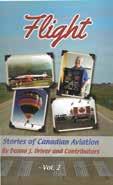
FLIGHT
Record-breaking flights, falling aircraft parts, balloon and helicopter trips and northern rescues are among the captivating true stories in this book. Early flight schools, animal obstacles, hijackings, and unique landing surfaces are also chronicled. Canadian pilots and aviation enthusiasts share stories of first flights, aerial skills, adventures, joys, perils, assistance, humour, tragedy and success in this salute to the Canadian aviation industry and its people.
AUTHOR: Deana Driver
PRICE: $27.95 (includes shipping)
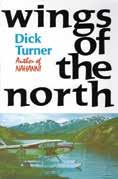
WINGS OF THE NORTH
From beside a fleecy cloud where the icy mountaintop hides a rising sun that will, in moments, bathe the little emerald lake with warmth and splendour, I dedicate this book to the ‘esprit de corps’ that exists among the bush pilots of the North. If there are any words in this book that will enable anyone now entering the world of aviation to become better and safer pilots, if it brings interest others, then I will be well satisfied that I have not failed in my objective.
AUTHOR: Dick Turner
PRICE: $24.95 (includes shipping)
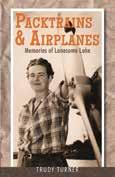
PACKTRAINS & AIRPLANES: MEMORIES OF LONESOME LAKE
Born in a remote homestead at Lonesome Lake in southwest B.C, Trudy Turner was raised in true pioneer fashion, without running water, electricity or cars. (Trudy learned to fly a plane in her twenties but didn’t get her motor vehicle driver’s licence until she was in her sixties.) Her parents began their homestead in 1912. When she was 24, Turner started her own homestead, building a home with the most basic hand tools. Published in 2012 when she was in her 80s, Turner reflects on her unusual life.
AUTHORS: Trudy Turner
PRICE: $39.95 (includes shipping)
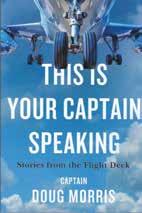
THIS IS YOUR CAPTAIN SPEAKING
For everyone from frequent fliers to aviation geeks, travel buffs to nervous travellers, Air Canada Captain Doug Morris tells you everything you want (and need!) to know about flight, such as whether airliners have keys, why the bumps, what aircrew get up to on layovers, what’s the deal with ‘mile-high memberships’, and how to become a pilot.
AUTHOR: Doug Morris
PRICE: $29.95 (includes shipping)

LADY ON A PEDESTAL
Gordon Bartsch recounts from a pilot’s perspective how he created an airline serving the Big Dipper Route in the Yukon Territory. The story’s heroes are a converted DC-3 (CF-CPY) and a young woman who earned the right to fly the Big Dipper Route from the left seat. Dawn and Gordon Bartsch shared a great adventure with a great airplane. Today, CF-CPY sits atop her pedestal in Whitehorse, turning into the wind, a testament to the Yukoners who did, and continue to do, what others said couldn’t be done.
AUTHOR: Gordon Bartsch
PRICE: $52.96 (includes shipping in Canada)
NEW NEW CANADIANAVIATOR.COM 51













SERVICE CENTRE PILOTMEDICALS.CA Dr. Stephen Cooper SCAN, CALL, FLY! Virtual Renewals Anytime, anywhere. In just 10 minutes. PRICE UPON REQUEST TOTAL TIME: 27.2 HRS. LIKE NEW • MANY EXTRAS Registered in Advanced Ultralight Category More photos on sellmyplane.ca CONTACT: Brewer Aviation Ltd. 902-626-5262 (John) jbrewer@eastlink.ca Flying is more fun in this Highlander! TOTAL TIME: 180 HRS. LIKE NEW (2013) • FULL ELECTRICS $79,700.00 CDN More photos on sellmyplane.ca CONTACT: Brewer Aviation Ltd. 902-626-5262 (John) jbrewer@eastlink.ca PRICE CHANGE REBUILT PIPER J-3 CUB/WAG AERO ADVERTISE IN THIS SECTION C ontact KATHERINE KJAER 250.592.5331 katherine@canadianaviator.com airbly.com 888-747-4565 AutomatedAircraft Logging,Tracking, andMore MadeinCanada *COPA MEMBERS RECEIVE EXTENDED WARRANTY. PNR $425 ANR BT $785 eatherlight CarbonFiber Tried & True Learn more at AVIATIONHEADSETS.CA 800-667-8140 HEADSETS@PRAIRIEFLYING.COM *COPA MEMBERS RECEIVE EXTENDED WARRANTY. HELMETS ANR BT $980 COMPLIMENTARY PILOTS WALLET THERE’S A REASON PILOTS USE Q SET 52 CANADIAN AVIATOR MAR/APR 2024

Does Your Airport Need Instrument Flight Procedures to Improve Access & Marketability?
Canada’s largest developer of GPS instrument approaches. > Over 150 airports in Canada use our approaches and departures.
Canada’s leading WAAS designers. > Over 100 airports and 200 approaches, including mountainous approaches to date.
Complete turnkey solution, from runway survey to flight checking, including WAAS flight checking.
Customized procedure design, including aircraft performance tailoring.




To advertise, contact Katherine Kjaer / 250.592.5331 / katherine@canadianaviator.com Fully insured Professional Engineering Firm APEGGA Permit to Practice Number P10042
Bellerose Drive, St. Albert AB, Canada T8N 5C9
info@jetpro.ca • 780-966-5902 #234, 3–11
HERE’S WHAT WE CAN DO FOR YOU: • Architectural & Engineered Drawings • Municipal Applications & Permits • Airport Applications & Approvals • Transport Canada & NavCan Applications • Complete Construction If you already have a design or drawings, send it along in CAD or PDF for an estimate to: steve.secco@secandco.com QUESTIONS? Phone 519.857.7639 or visit www.secandco.com CANADIANAVIATOR.COM 53
Within this puzzle are the names of Murphy Aircraft aircraft models (clues marked with an *). All other answers are aviation related.
1) How much weight is a layer of paint estimated to add to the overall weight of an Airbus A380?
a) 1,400 lbs.
b) 400 lbs.
c) 800 lbs.
d) 1,800 lbs.
2) What is a “critical engine” when referring to a multi-engine, fixed-wing aircraft?
a) It is the engine which, if it failed, would most adversely affect the aircraft’s performance.
b) It is the engine with a prop rotating in the conventional direction to a single-engine aircraft.
c) It is the engine that drives the alternator.
d) It is the engine from which a fuel pump is driven.
3) What is the class of airspace in Canada’s northern domestic airspace between 18,000 ft ASL and FL230?
a) Class G.
b) Class C.
c) Class A.
d) Class E.
4) Who was the first Canadian to fly an aeroplane and where did the flight take place?
a) John McCurdy, in Baddeck, Nova Scotia.
b) John Porte, in Le Mans, France.
c) Frederick Walker Baldwin, in Hammondsport, New York.
d) Louis Anselm Lauriat, in Saint John, New Brunswick.
5) The letters in the “I’M SAFE” checklist for pilot self-assessment stand for what?
a) Illness, Medication, Sickness, Anxiety, Fear, Environment.
b) Indecisive, Malcontent, Stressed, Anxious, Fatigued, Edgy.
c) Illness, Medication, Stress, Alcohol, Fatigue, Eating.
d) It’s a mnemonic for “I am sound and fully engaged.”
JAN/FEB ANSWER KEY More Grumman Aircraft Models
6) What determines the permission to take off from an aerodrome on an IFR flight plan?
a) The availability of runway lighting.
b) The horizontal visibility at the surface.
c) The vertical visibility at the surface.
d) The height of the cloud ceiling.
7) Where does a jet stream form?
a) At the boundary between maritime and continental air masses.
b) Along a line joining the centres of low-pressure areas.
c) At the boundary between two air masses of different temperature.
d) North of the polar high-pressure ridge.
1 2 3 4 5 6 7 8 9 10 11 12 13 14 15 16 17 18 19 20 21 22 23 24 25 26 27 28 29 ACROSS 6 Coming after November. 7 Bad news for aircraft skin. 9 Deserter.* 11 Aircraft weight units, per TC. 12 Often disrupts air travel over Sicily. 14 Maker of popular aviation headsets. 15 Comanches and Cherokees. 16 Weather condition requiring an IFR plan. 17 ___ Without A Cause (1955 movie).* 18 Host of famous air races. 20 Controls pitch. 22 One component of an aircraft’s acquisition cost. 23 An essential time commercial pilots must record. 26 RCAF Husky maker. 27 A Ford pickup truck model.* 28 A kit plane requires this. 29 The ‘R’ in Nav Canada’s FIR. DOWN 1 Largest member of the deer family.* 2 Val Kilmer’s role in Top Gun 3 A type of north. 4 Opposite from crosswind. 5 Long, spar-like structures in an aircraft.
— Refresh Your Memory BY GRAEME PEPPLER FLIGHT BAG More Grumman Aircraft Models Within this puzzle are names of 10 Grumman aircraft models (clues marked with an *). All other answers are aviation related. 1C U B 2A I 3D R 4 J A 5G U A R N 6 I M 7C O E U C 8D O N A 9S E A T T L E 10H T G S S F 11T R A C E R E 12W A C S W U I T K 13E D G E N 14P R O W L E R E 15D R A G E Y R A 16G E 17A R 18T 19T U G 20M 21A G U 22M O I 23B Z 24G R A H A M 25G E N E R A T O R O Z C E D E R A 26R A V E N C 27B E A R C A T
Aviation Crossword Puzzle — Murphy Models
8 U.N. agency dedicated to aviation affairs. 9 An extremist person or idea.* 10 Top strata of society, perhaps.* 13 CYZZ 15 Region between Russia and Canada. 17 Fasteners used in aircraft construction. 18 Controls yaw. 19 City hosting TC HQ. 20 Popular air race planes. 21 It reduces control pressure. 24 A GMC SUV model.* 25 Might be said on a radio after a message is complete. 1. a 2. a 3. a 4. c 5. c 6. b 7. c 54 CANADIAN AVIATOR MAR/APR 2024
Meet Atticus
5 years old from Kelowna, BC
• Battling nervous system disorder, myasthenia gravis
• Started travelling with Hope Air in 2022
• 11 trips
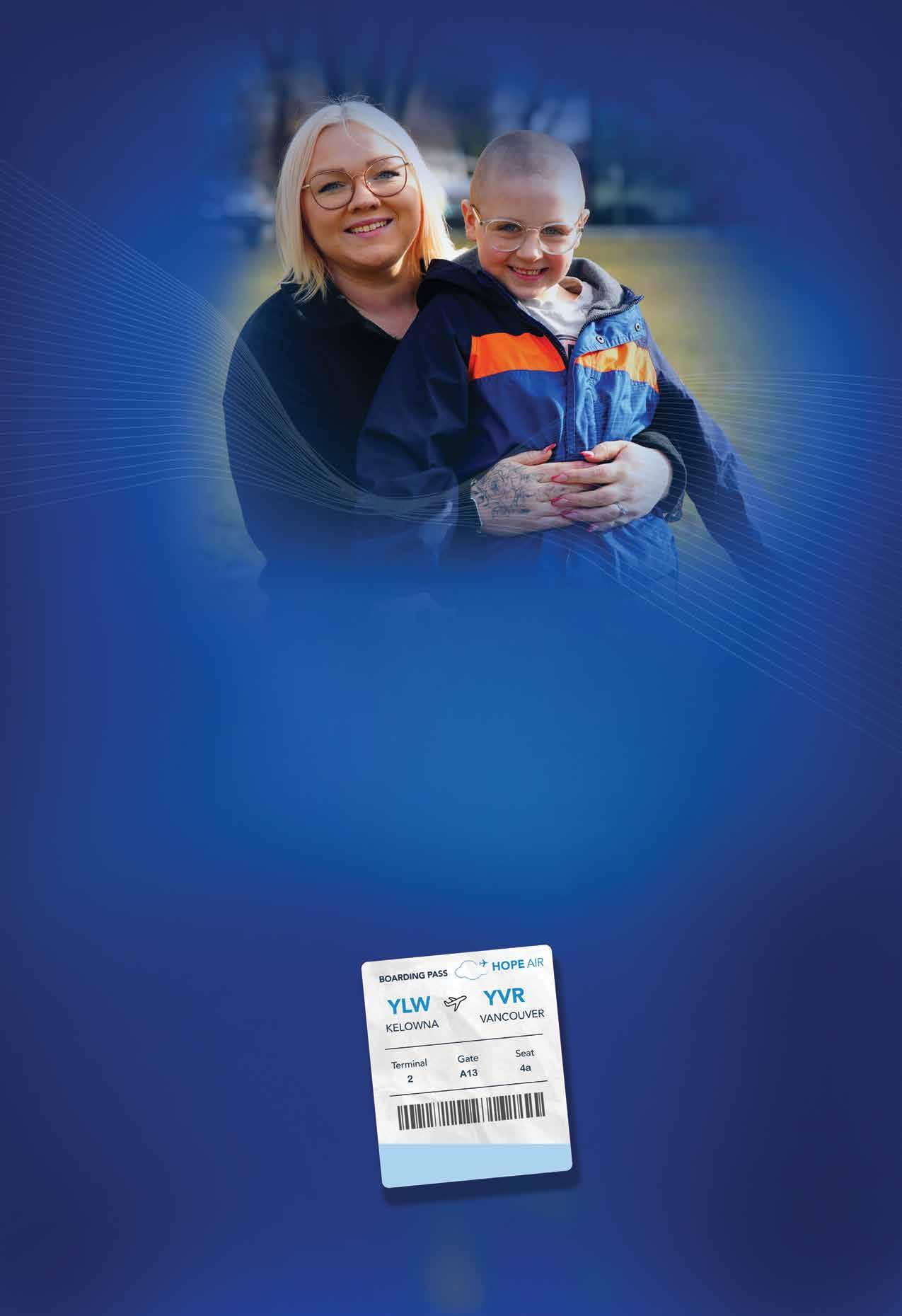
Help patients get to life saving medical care. Your support means no patient in need will be left behind.
Learn more at Hopeair.ca


COMPROMISE WARRANTY.
CARE COMES WITH A 5-YEAR COVERAGE ON ALL PARTS AND THE NEW BOSE A30 AVIATION HEADSET.


AUTHORISED
*In the Americas, Rotax Care is only available upon purchasing a new 912iS or 916iS engine. Due to legal & insurance requirements, a warranty upgrade after purchase and delivery is not possible. Bose A30 headsets are included with Rotax Care for a limited time only.
ROTAX DISTRIBUTOR THE NO-
ROTAX





















































 Backman prepares his plane for his attempt at a trans-Atlantic flight from Gander, Newfoundland to Stockholm, Sweden.
Backman prepares his plane for his attempt at a trans-Atlantic flight from Gander, Newfoundland to Stockholm, Sweden.








 SPENCER DAVIS
SPENCER DAVIS






 BY CURTIS PENNER | PHOTOS BY RICK HIEBERT
BY CURTIS PENNER | PHOTOS BY RICK HIEBERT




 In the vicinity of Mt. McKinley in Denali National Park.
In the vicinity of Mt. McKinley in Denali National Park.




 BY ROBERT S. GRANT
BY ROBERT S. GRANT
 ROBERT S. GRANT
ROBERT S. GRANT






































